Favipiravir Analogues as Inhibitors of SARS-CoV-2 RNA-Dependent RNA Polymerase, Combined Quantum Chemical Modeling, Quantitative Structure–Property Relationship, and Molecular Docking Study
Abstract
1. Introduction
1.1. Motivation of the Research
1.2. Favipiravir–State of the Art
1.3. Favipiravir—Unique Mechanism of Action
1.4. FVP Analogues—A Research Hypothesis and Concept
2. Results and Discussion
2.1. Characteristics of the Candidate Ligands
2.1.1. Physicochemical Profile (ADMET) and Key Pharmacokinetic Parameters
2.1.2. Reactivity Profile (Quantitative Structure–Property Relationships)
2.2. Characteristic of RNA-Directed RNA Polymerase
2.3. Binding Modes of the Native and Candidate Ligands to RdRp in Different States
2.3.1. Pre-Catalytic State—Productive Mode I (Binding to Cytosine and Stacking to Adenosine)
Binding Mode of the Native FVP-RTP Ligand to RdRp
Binding Mode of the Candidate Ligands to RdRp
- Docking Results
- In-Depth Analysis of the Binding Mode
- Binding Mode Visualization
2.3.2. Pre-Catalytic State—Productive Mode II (Binding to Uracil and Stacking to Guanosine)
Binding of the Native RVD Ligand to RdRp
Binding Mode of the Candidate Ligands to RdRp
- Docking Results
- In-Depth Analysis of the Binding Mode
- Binding Mode Visualization
2.3.3. Pre-Catalytic State—Non-Productive Mode
Docking Results
In-Depth Analysis of the Binding Mode
Binding Mode Visualization
2.3.4. Active State
Docking Results
In-Depth Analysis of the Binding Mode
Binding Mode Visualization
2.3.5. Allosteric Effect
Docking Results
In-Depth Analysis of the Binding Mode
Binding Mode Visualization
2.4. Comparison of the Productive, Non-Productive, Active State and Allosteric Site Binding Modes
3. Methods
3.1. ADME and Drug-Likeness Prediction
3.2. Density Functional Theory
3.3. Quantum Theory of Atoms in Molecules
3.4. Molecular Docking
3.5. Comparison of the Differences in the Binding Modes—Mathematical Metrics
- Euclidian distance ;
- Manhattan distance ;
- the additive formula ;
- cosine distance ;
- Tanimoto distance ;
4. Conclusions
Supplementary Materials
Author Contributions
Funding
Institutional Review Board Statement
Informed Consent Statement
Data Availability Statement
Acknowledgments
Conflicts of Interest
Abbreviations
| Abbreviation | Meaning |
| ADME | Absorption, Distribution, Metabolism, and Excretion |
| BBB | blood–brain barrier |
| CYP | cytochrome P450 |
| DFT | Density Functional Theory |
| DILI | drug-induced liver injury |
| DOI | degree of interaction |
| FVP | favipiravir |
| GI | gastrointestinal absorption |
| HGPRT | hypoxanthinguanine phosphoribosyl transferase |
| H-HT | hepatotoxicity |
| MD | Molecular Docking |
| MOL | Molnupiravir |
| NMVr | Nirmatrelvir |
| PAINS | Pan Assay of Interference Structures |
| PCM | polarizable continuum model |
| P-gp | permeability glycoprotein |
| QSPR | Quantum Quantitative Structure–Property Relationship |
| QTAIM | Quantum Theory of Atoms in Molecules |
| RDG | Reduced Density Gradient |
| RdRp | RNA-dependent RNA polymerase |
| RDP | ribonucleoside-5′-diphosphate |
| RMP | ribonucleoside-5′-monophosphate |
| RTP | ribonucleoside-5′-triphosphate |
| RTV | Ritonavir |
| RNA | ribonucleic acid |
| RVD | Remdesivir |
| RBV | Ribavirin |
| SAS | synthetic accessibility score |
| ssRNA | single-stranded RNA viruses |
| TPSA | topological polar surface area |
References
- Perlman, S. Another Decade, Another Coronavirus. N. Engl. J. Med. 2020, 382, 760–762. [Google Scholar] [CrossRef]
- Zhang, T.; Wu, Q.; Zhang, Z. Probable Pangolin Origin of SARS-CoV-2 Associated with the COVID-19 Outbreak. Curr. Biol. 2020, 30, 1578. [Google Scholar] [CrossRef]
- WHO. Tracking SARS-CoV-2 Variants. Available online: https://www.who.int/activities/tracking-SARS-CoV-2-variants (accessed on 27 September 2023).
- Taubenberger, J.K.; Morens, D.M. 1918 Influenza: The Mother of All Pandemics. Emerg. Infect. Dis. 2006, 12, 15–22. [Google Scholar] [CrossRef] [PubMed]
- Hartman, A.L.; Zadeh, V.R.; Afowowe, T.O.; Abe, H.; Urata, S.; Yasuda, J. Potential and action mechanism of favipiravir as an antiviral against Junin virus. PLoS Pathog. 2022, 18, e1010689. [Google Scholar] [CrossRef]
- Konda, M.; Dodda, B.; Konala, V.M.; Naramala, S.; Adapa, S. Potential Zoonotic Origins of SARS-CoV-2 and Insights for Preventing Future Pandemics Through One Health Approach. Cureus 2020, 12, e8932. [Google Scholar] [CrossRef] [PubMed]
- Harris, A.; Sha, B.; Luo, M. Structural similarities between influenza virus matrix protein M1 and human immunodeficiency virus matrix and capsid proteins: An evolutionary link between negative-stranded RNA viruses and retroviruses. J. Gen. Virol. 1999, 80, 863–869. [Google Scholar] [CrossRef][Green Version]
- Bar-On, Y.M.; Flamholz, A.; Phillips, R.; Milo, R. SARS-CoV-2 (COVID-19) by the numbers. eLife 2020, 9, e57309. [Google Scholar] [CrossRef] [PubMed]
- Kosik, I.; Yewdell, J.W. Influenza Hemagglutinin and Neuraminidase: Yin-Yang Proteins Coevolving to Thwart Immunity. Viruses 2019, 11, 346. [Google Scholar] [CrossRef]
- Letko, M.; Marzi, A.; Munster, V. Functional assessment of cell entry and receptor usage for SARS-CoV-2 and other lineage B betacoronaviruses. Nat. Microbiol. 2020, 5, 562–569. [Google Scholar] [CrossRef]
- Fantini, J.; Chahinian, H.; Yahi, N. Convergent Evolution Dynamics of SARS-CoV-2 and HIV Surface Envelope Glycoproteins Driven by Host Cell Surface Receptors and Lipid Rafts: Lessons for the Future. Int. J. Mol. Sci. 2023, 24, 1923. [Google Scholar] [CrossRef]
- Robson, F.; Khan, K.S.; Le, T.K.; Paris, C.; Demirbag, S.; Barfuss, P.; Rocchi, P.; Ng, W.-L. Coronavirus RNA Proofreading: Molecular Basis and Therapeutic Targeting. Mol. Cell 2020, 79, 710–727. [Google Scholar] [CrossRef]
- Kuhn, J.H.; Becker, S.; Ebihara, H.; Geisbert, T.W.; Johnson, K.M.; Kawaoka, Y.; Lipkin, W.I.; Negredo, A.I.; Netesov, S.V.; Nichol, S.T.; et al. Proposal for a revised taxonomy of the family Filoviridae: Classification, names of taxa and viruses, and virus abbreviations. Arch. Virol. 2010, 155, 2083–2103. [Google Scholar] [CrossRef] [PubMed]
- Cheung, C.L.; Rayner, J.M.; Smith, G.J.D.; Wang, P.; Naipospos, T.S.P.; Zhang, J.; Yuen, K.Y.; Webster, R.G.; Peiris, J.S.M.; Guan, Y.; et al. Distribution of Amantadine-Resistant H5N1 Avian Influenza Variants in Asia. J. Infect. Dis. 2006, 193, 1626–1629. [Google Scholar] [CrossRef]
- Deyde, V.M.; Xu, X.; Bright, R.A.; Shaw, M.; Smith, C.B.; Zhang, Y.; Shu, Y.; Gubareva, L.V.; Cox, N.J.; Klimov, A.I. Surveillance of Resistance to Adamantanes among Influenza A(H3N2) and A(H1N1) Viruses Isolated Worldwide. J. Infect. Dis. 2007, 196, 249–257. [Google Scholar] [CrossRef] [PubMed]
- Nelson, M.I.; Simonsen, L.; Viboud, C.; Miller, M.A.; Holmes, E.C. The origin and global emergence of adamantane resistant A/H3N2 influenza viruses. Virology 2009, 388, 270–278. [Google Scholar] [CrossRef] [PubMed]
- Hata, M.; Tanaka, S.; Yasui, Y.; Fujiwara, N.; Kobayashi, S.; Minagawa, H. Rapid Genotypic Assay for Detection of Oseltamivir-Resistant Influenza A (H1N1) Viruses. J. Clin. Microbiol. 2010, 48, 1983–1984. [Google Scholar] [CrossRef] [PubMed][Green Version]
- Earhart, K.C.; Elsayed, N.M.; Saad, M.D.; Gubareva, L.V.; Nayel, A.; Deyde, V.M.; Abdelsattar, A.; Abdelghani, A.S.; Boynton, B.R.; Mansour, M.M.; et al. Oseltamivir resistance mutation N294S in human influenza A(H5N1) virus in Egypt. J. Infect. Public Health 2009, 2, 74–80. [Google Scholar] [CrossRef]
- Meijer, A.; Lackenby, A.; Hungnes, O.; Lina, B.; van der Werf, S.; Schweiger, B.; Opp, M.; Paget, J.; van de Kassteele, J.; Hay, A.; et al. Oseltamivir-Resistant Influenza Virus A (H1N1), Europe, 2007–2008 Season. Emerg. Infect. Dis. 2009, 15, 552–560. [Google Scholar] [CrossRef]
- Report on the Deliberation Results March 4, 2014 Evaluation and Licensing Division, Pharmaceutical and Food Safety Bureau Ministry of Health, Labour and Welfare, Pharmaceuticals and Medical Devices Agency. Available online: https://www.pmda.go.jp/files/000210319.pdf (accessed on 27 September 2023).
- Hayden, F.G.; Lenk, R.P.; Stonis, L.; Oldham-Creamer, C.; Kang, L.L.; Epstein, C. Favipiravir Treatment of Uncomplicated Influenza in Adults: Results of Two Phase 3, Randomized, Double-Blind, Placebo-Controlled Trials. J. Infect. Dis. 2022, 226, 1790–1799. [Google Scholar] [CrossRef]
- Takashita, E.; Ejima, M.; Ogawa, R.; Fujisaki, S.; Neumann, G.; Furuta, Y.; Kawaoka, Y.; Tashiro, M.; Odagiri, T. Antiviral susceptibility of influenza viruses isolated from patients pre- and post-administration of favipiravir. Antivir. Res. 2016, 132, 170–177. [Google Scholar] [CrossRef]
- Jordan, P.C.; Stevens, S.K.; Deval, J. Nucleosides for the treatment of respiratory RNA virus infections. Antivir. Chem. Chemother. 2018, 26, 2040206618764483. [Google Scholar] [CrossRef] [PubMed]
- Watanabe, M. The COVID-19 Pandemic in Japan. Surg. Today 2020, 50, 787–793. [Google Scholar] [CrossRef] [PubMed]
- Kumar, R.; Gupta, N.; Kodan, P.; Mittal, A.; Soneja, M.; Wig, N. Battling COVID-19: Using old weapons for a new enemy. Trop. Dis. Travel Med. Vaccines 2020, 6, 6. [Google Scholar] [CrossRef] [PubMed]
- Şimşek Yavuz, S.; ÜNal, S. Antiviral treatment of COVID-19. Turk. J. Med. Sci. 2020, 50, 611–619. [Google Scholar] [CrossRef]
- Delang, L.; Abdelnabi, R.; Neyts, J. Favipiravir as a potential countermeasure against neglected and emerging RNA viruses. Antivir. Res. 2018, 153, 85–94. [Google Scholar] [CrossRef]
- Furuta, Y.; Komeno, T.; Nakamura, T. Favipiravir (T-705), a broad spectrum inhibitor of viral RNA polymerase. Proc. Jpn. Acad. Ser. B 2017, 93, 449–463. [Google Scholar] [CrossRef]
- Bai, C.-Q.; Mu, J.-S.; Kargbo, D.; Song, Y.-B.; Niu, W.-K.; Nie, W.-M.; Kanu, A.; Liu, W.-W.; Wang, Y.-P.; Dafae, F.; et al. Clinical and Virological Characteristics of Ebola Virus Disease Patients Treated With Favipiravir (T-705)—Sierra Leone, 2014. Clin. Infect. Dis. 2016, 63, 1288–1294. [Google Scholar] [CrossRef]
- Rosenke, K.; Feldmann, H.; Westover, J.B.; Hanley, P.W.; Martellaro, C.; Feldmann, F.; Saturday, G.; Lovaglio, J.; Scott, D.P.; Furuta, Y.; et al. Use of Favipiravir to Treat Lassa Virus Infection in Macaques. Emerg. Infect. Dis. 2018, 24, 1696–1699. [Google Scholar] [CrossRef]
- Escribano-Romero, E.; Jiménez de Oya, N.; Domingo, E.; Saiz, J.C. Extinction of West Nile Virus by Favipiravir through Lethal Mutagenesis. Antimicrob. Agents Chemother. 2017, 61, 10–1128. [Google Scholar] [CrossRef]
- Marlin, R.; Desjardins, D.; Contreras, V.; Lingas, G.; Solas, C.; Roques, P.; Naninck, T.; Pascal, Q.; Behillil, S.; Maisonnasse, P.; et al. Antiviral efficacy of favipiravir against Zika and SARS-CoV-2 viruses in non-human primates. Nat. Commun. 2022, 13, 5108. [Google Scholar] [CrossRef]
- Williams, M.; Caroline, A.L.; Powell, D.S.; Bethel, L.M.; Oury, T.D.; Reed, D.S.; Hartman, A.L. Broad Spectrum Antiviral Activity of Favipiravir (T-705): Protection from Highly Lethal Inhalational Rift Valley Fever. PLoS Negl. Trop. Dis. 2014, 8, e2790. [Google Scholar] [CrossRef]
- Julander, J.G.; Shafer, K.; Smee, D.F.; Morrey, J.D.; Furuta, Y. Activity of T-705 in a Hamster Model of Yellow Fever Virus Infection in Comparison with That of a Chemically Related Compound, T-1106. Antimicrob. Agents Chemother. 2009, 53, 202–209. [Google Scholar] [CrossRef]
- Singh, S.K.; Oestereich, L.; Rieger, T.; Neumann, M.; Bernreuther, C.; Lehmann, M.; Krasemann, S.; Wurr, S.; Emmerich, P.; de Lamballerie, X.; et al. Evaluation of Antiviral Efficacy of Ribavirin, Arbidol, and T-705 (Favipiravir) in a Mouse Model for Crimean-Congo Hemorrhagic Fever. PLoS Negl. Trop. Dis. 2014, 8, e2804. [Google Scholar] [CrossRef]
- Bologheanu, R.; Schubert, L.; Thurnher, M.; Schiefer, J.; Santonja, I.; Holzmann, H.; Oesterreicher, Z.; Tobudic, S.; Winkler, S.; Faybik, P.; et al. Unexpected complete recovery of a patient with severe tick-borne encephalitis treated with favipiravir. Antivir. Res. 2020, 184, 104952. [Google Scholar] [CrossRef]
- Banyard, A.C.; Mansfield, K.L.; Wu, G.; Selden, D.; Thorne, L.; Birch, C.; Koraka, P.; Osterhaus, A.D.M.E.; Fooks, A.R. Re-evaluating the effect of Favipiravir treatment on rabies virus infection. Vaccine 2019, 37, 4686–4693. [Google Scholar] [CrossRef] [PubMed]
- Veliziotis, I.; Roman, A.; Martiny, D.; Schuldt, G.; Claus, M.; Dauby, N.; Van den Wijngaert, S.; Martin, C.; Nasreddine, R.; Perandones, C.; et al. Clinical Management of Argentine Hemorrhagic Fever using Ribavirin and Favipiravir, Belgium, 2020. Emerg. Infect. Dis. 2020, 26, 1562–1566. [Google Scholar] [CrossRef] [PubMed]
- Agrawal, U.; Raju, R.; Udwadia, Z.F. Favipiravir: A new and emerging antiviral option in COVID-19. Med. J. Armed Forces India 2020, 76, 370–376. [Google Scholar] [CrossRef] [PubMed]
- Joshi, S.; Parkar, J.; Ansari, A.; Vora, A.; Talwar, D.; Tiwaskar, M.; Patil, S.; Barkate, H. Role of favipiravir in the treatment of COVID-19. Int. J. Infect. Dis. 2021, 102, 501–508. [Google Scholar] [CrossRef]
- Mallhi, T.H.; Fathi, M.; Vakili, K.; Sayehmiri, F.; Mohamadkhani, A.; Hajiesmaeili, M.; Rezaei-Tavirani, M.; Eilami, O. The prognostic value of comorbidity for the severity of COVID-19: A systematic review and meta-analysis study. PLoS ONE 2021, 16, e0246190. [Google Scholar] [CrossRef]
- Wang, Y.; Li, P.; Rajpoot, S.; Saqib, U.; Yu, P.; Li, Y.; Li, Y.; Ma, Z.; Baig, M.S.; Pan, Q. Comparative assessment of favipiravir and remdesivir against human coronavirus NL63 in molecular docking and cell culture models. Sci. Rep. 2021, 11, 23465. [Google Scholar] [CrossRef]
- Gunaydin-Akyildiz, A.; Aksoy, N.; Boran, T.; Ilhan, E.N.; Ozhan, G. Favipiravir induces oxidative stress and genotoxicity in cardiac and skin cells. Toxicol. Lett. 2022, 371, 9–16. [Google Scholar] [CrossRef]
- Kumar, P.; Kulkarni, A.; Sharma, M.; Rao, P.N.; Reddy, D.N. Favipiravir-induced Liver Injury in Patients with Coronavirus Disease 2019. J. Clin. Transl. Hepatol. 2021, 9, 276. [Google Scholar] [CrossRef] [PubMed]
- Madelain, V.; Mentré, F.; Baize, S.; Anglaret, X.; Laouénan, C.; Oestereich, L.; Nguyen, T.H.T.; Malvy, D.; Piorkowski, G.; Graw, F.; et al. Modeling Favipiravir Antiviral Efficacy Against Emerging Viruses: From Animal Studies to Clinical Trials. CPT Pharmacomet. Syst. Pharmacol. 2020, 9, 258–271. [Google Scholar] [CrossRef]
- Tırmıkçıoğlu, Z. Favipiravir exposure and pregnancy outcome of COVID-19 patients. Eur. J. Obstet. Gynecol. Reprod. Biol. 2022, 268, 110–115. [Google Scholar] [CrossRef] [PubMed]
- Ertem, O.; Guner, O.; Incir, C.; Kalkan, S.; Gelal, A. The outcomes of favipiravir exposure in pregnancy: A case series. Arch. Gynecol. Obstet. 2022, 307, 1385–1395. [Google Scholar] [CrossRef] [PubMed]
- Nagata, T.; Lefor, A.K.; Hasegawa, M.; Ishii, M. Favipiravir: A New Medication for the Ebola Virus Disease Pandemic. Disaster Med. Public Health Prep. 2014, 9, 79–81. [Google Scholar] [CrossRef] [PubMed]
- Casalini, G.; Giacomelli, A.; Antinori, S. Liver tests abnormalities with licensed antiviral drugs for COVID-19: A narrative review. Expert Opin. Drug Saf. 2023, 21, 1483–1494. [Google Scholar] [CrossRef] [PubMed]
- Dufour, I.; Devresse, A.; Scohy, A.; Briquet, C.; Georgery, H.; Delaey, P.; Greef, J.D.; Goffin, E.; Labriola, L. Safety and efficiency of molnupiravir for COVID-19 patients with advanced chronic kidney disease. Kidney Res. Clin. Pract. 2023, 42, 275–278. [Google Scholar] [CrossRef]
- Zhou, S.; Hill, C.S.; Sarkar, S.; Tse, L.V.; Woodburn, B.M.D.; Schinazi, R.F.; Sheahan, T.P.; Baric, R.S.; Heise, M.T.; Swanstrom, R. β-d-N4-hydroxycytidine Inhibits SARS-CoV-2 Through Lethal Mutagenesis But Is Also Mutagenic To Mammalian Cells. J. Infect. Dis. 2021, 224, 415–419. [Google Scholar] [CrossRef]
- Smee, D.F.; Hurst, B.L.; Wong, M.-H.; Bailey, K.W.; Tarbet, E.B.; Morrey, J.D.; Furuta, Y. Effects of the Combination of Favipiravir (T-705) and Oseltamivir on Influenza A Virus Infections in Mice. Antimicrob. Agents Chemother. 2010, 54, 126–133. [Google Scholar] [CrossRef]
- Smee, D.F.; Tarbet, E.B.; Furuta, Y.; Morrey, J.D.; Barnard, D.L. Synergistic combinations of favipiravir and oseltamivir against wild-type pandemic and oseltamivir-resistant influenza A virus infections in mice. Future Virol. 2013, 8, 1085–1094. [Google Scholar] [CrossRef]
- Sarojvisut, P.; Apisarnthanarak, A.; Jantarathaneewat, K.; Sathitakorn, O.; Pienthong, T.; Mingmalairak, C.; Warren, D.K.; Weber, D.J. An Open Label Randomized Controlled Trial of Ivermectin Plus Favipiravir-Based Standard of Care versus Favipiravir-Based Standard of Care for Treatment of Moderate COVID-19 in Thailand. Infect. Chemother. 2023, 55, 50. [Google Scholar] [CrossRef]
- Oestereich, L.; Rieger, T.; Lüdtke, A.; Ruibal, P.; Wurr, S.; Pallasch, E.; Bockholt, S.; Krasemann, S.; Muñoz-Fontela, C.; Günther, S. Efficacy of Favipiravir Alone and in Combination With Ribavirin in a Lethal, Immunocompetent Mouse Model of Lassa Fever. J. Infect. Dis. 2016, 213, 934–938. [Google Scholar] [CrossRef] [PubMed]
- Zhao, H.; Zhu, Q.; Zhang, C.; Li, J.; Wei, M.; Qin, Y.; Chen, G.; Wang, K.; Yu, J.; Wu, Z.; et al. Tocilizumab combined with favipiravir in the treatment of COVID-19: A multicenter trial in a small sample size. Biomed. Pharmacother. 2021, 133, 110825. [Google Scholar] [CrossRef] [PubMed]
- Abdel-Halim, H.; Hajar, M.; Hasouneh, L.; Abdelmalek, S.M.A. Identification of Drug Combination Therapies for SARS-CoV-2: A Molecular Dynamics Simulations Approach. Drug Des. Dev. Ther. 2022, 16, 2995–3013. [Google Scholar] [CrossRef]
- Rubin, D.; Chan-Tack, K.; Farley, J.; Sherwat, A. FDA Approval of Remdesivir—A Step in the Right Direction. N. Engl. J. Med. 2020, 383, 2598–2600. [Google Scholar] [CrossRef] [PubMed]
- Gérard, A.O.; Laurain, A.; Fresse, A.; Parassol, N.; Muzzone, M.; Rocher, F.; Esnault, V.L.M.; Drici, M.D. Remdesivir and Acute Renal Failure: A Potential Safety Signal From Disproportionality Analysis of the WHO Safety Database. Clin. Pharmacol. Ther. 2021, 109, 1021–1024. [Google Scholar] [CrossRef]
- Stevens, L.J.; Pruijssers, A.J.; Lee, H.W.; Gordon, C.J.; Tchesnokov, E.P.; Gribble, J.; George, A.S.; Hughes, T.M.; Lu, X.; Li, J.; et al. Mutations in the SARS-CoV-2 RNA-dependent RNA polymerase confer resistance to remdesivir by distinct mechanisms. Sci. Transl. Med. 2022, 14, eabo0718. [Google Scholar] [CrossRef]
- Sangawa, H.; Komeno, T.; Nishikawa, H.; Yoshida, A.; Takahashi, K.; Nomura, N.; Furuta, Y. Mechanism of Action of T-705 Ribosyl Triphosphate against Influenza Virus RNA Polymerase. Antimicrob. Agents Chemother. 2013, 57, 5202–5208. [Google Scholar] [CrossRef]
- Baranovich, T.; Wong, S.-S.; Armstrong, J.; Marjuki, H.; Webby, R.J.; Webster, R.G.; Govorkova, E.A. T-705 (Favipiravir) Induces Lethal Mutagenesis in Influenza A H1N1 Viruses In Vitro. J. Virol. 2013, 87, 3741–3751. [Google Scholar] [CrossRef]
- Naesens, L.; Guddat, L.W.; Keough, D.T.; van Kuilenburg, A.B.P.; Meijer, J.; Vande Voorde, J.; Balzarini, J. Role of Human Hypoxanthine Guanine Phosphoribosyltransferase in Activation of the Antiviral Agent T-705 (Favipiravir). Mol. Pharmacol. 2013, 84, 615–629. [Google Scholar] [CrossRef] [PubMed]
- Latosińska, J.N.; Latosińska, M.; Seliger, J.; Žagar, V.; Apih, T.; Grieb, P. Elucidating the Role of Noncovalent Interactions in Favipiravir, a Drug Active against Various Human RNA Viruses; a 1H-14N NQDR/Periodic DFT/QTAIM/RDS/3D Hirshfeld Surfaces Combined Study. Molecules 2023, 28, 3308. [Google Scholar] [CrossRef] [PubMed]
- Etter, M.C. Encoding and decoding hydrogen-bond patterns of organic compounds. Acc. Chem. Res. 2002, 23, 120–126. [Google Scholar] [CrossRef]
- Daina, A.; Michielin, O.; Zoete, V. SwissADME: A free web tool to evaluate pharmacokinetics, drug-likeness and medicinal chemistry friendliness of small molecules. Sci. Rep. 2017, 7, 42717. [Google Scholar] [CrossRef]
- Jia, H.; Häring, A.P.; Berger, F.; Zhang, L.; Ritter, T. Trifluoromethyl Thianthrenium Triflate: A Readily Available Trifluoromethylating Reagent with Formal CF3+, CF3•, and CF3− Reactivity. J. Am. Chem. Soc. 2021, 143, 7623–7628. [Google Scholar] [CrossRef]
- Mucker, E.M.; Goff, A.J.; Shamblin, J.D.; Grosenbach, D.W.; Damon, I.K.; Mehal, J.M.; Holman, R.C.; Carroll, D.; Gallardo, N.; Olson, V.A.; et al. Efficacy of Tecovirimat (ST-246) in Nonhuman Primates Infected with Variola Virus (Smallpox). Antimicrob. Agents Chemother. 2013, 57, 6246–6253. [Google Scholar] [CrossRef]
- Wang, Z.; Yu, Z.; Kang, D.; Zhang, J.; Tian, Y.; Daelemans, D.; De Clercq, E.; Pannecouque, C.; Zhan, P.; Liu, X. Design, synthesis and biological evaluation of novel acetamide-substituted doravirine and its prodrugs as potent HIV-1 NNRTIs. Bioorg. Med. Chem. 2019, 27, 447–456. [Google Scholar] [CrossRef] [PubMed]
- Turner, S.R.; Strohbach, J.W.; Tommasi, R.A.; Aristoff, P.A.; Johnson, P.D.; Skulnick, H.I.; Dolak, L.A.; Seest, E.P.; Tomich, P.K.; Bohanon, M.J.; et al. Tipranavir (PNU-140690): A Potent, Orally Bioavailable Nonpeptidic HIV Protease Inhibitor of the 5,6-Dihydro-4-hydroxy-2-pyrone Sulfonamide Class. J. Med. Chem. 1998, 41, 3467–3476. [Google Scholar] [CrossRef]
- Xiong, G.; Wu, Z.; Yi, J.; Fu, L.; Yang, Z.; Hsieh, C.; Yin, M.; Zeng, X.; Wu, C.; Lu, A.; et al. ADMETlab 2.0: An integrated online platform for accurate and comprehensive predictions of ADMET properties. Nucleic Acids Res. 2021, 49, W5–W14. [Google Scholar] [CrossRef]
- Gao, Z.-G.; Jacobson, K.A. Emerging adenosine receptor agonists. Expert Opin. Emerg. Drugs 2007, 12, 479–492. [Google Scholar] [CrossRef]
- Xu, X. Molecular model of SARS coronavirus polymerase: Implications for biochemical functions and drug design. Nucleic Acids Res. 2003, 31, 7117–7130. [Google Scholar] [CrossRef] [PubMed]
- Gao, Y.; Yan, L.; Huang, Y.; Liu, F.; Zhao, Y.; Cao, L.; Wang, T.; Sun, Q.; Ming, Z.; Zhang, L.; et al. Structure of the RNA-dependent RNA polymerase from COVID-19 virus. Science 2020, 368, 779–782. [Google Scholar] [CrossRef] [PubMed]
- Tao, Y.; Farsetta, D.L.; Nibert, M.L.; Harrison, S.C. RNA Synthesis in a Cage—Structural Studies of Reovirus Polymerase λ3. Cell 2002, 111, 733–745. [Google Scholar] [CrossRef] [PubMed]
- Butcher, S.J.; Grimes, J.M.; Makeyev, E.V.; Bamford, D.H.; Stuart, D.I. A mechanism for initiating RNA-dependent RNA polymerization. Nature 2001, 410, 235–240. [Google Scholar] [CrossRef]
- Jacobo-Molina, A.; Ding, J.; Nanni, R.G.; Clark, A.D.; Lu, X.; Tantillo, C.; Williams, R.L.; Kamer, G.; Ferris, A.L.; Clark, P. Crystal structure of human immunodeficiency virus type 1 reverse transcriptase complexed with double-stranded DNA at 3.0 A resolution shows bent DNA. Proc. Natl. Acad. Sci. USA 1993, 90, 6320–6324. [Google Scholar] [CrossRef]
- Latosińska, J.N.; Latosińska, M.; Orzeszko, A.; Maurin, J.K. Synthesis and Crystal Structure of Adamantylated 4,5,6,7-Tetrahalogeno-1H-benzimidazoles Novel Multi-Target Ligands (Potential CK2, M2 and SARS-CoV-2 Inhibitors); X-ray/DFT/QTAIM/Hirshfeld Surfaces/Molecular Docking Study. Molecules 2022, 28, 147. [Google Scholar] [CrossRef]
- Latosińska, J.N.; Latosińska, M.; Maurin, J.K.; Orzeszko, A.; Kazimierczuk, Z. Quantum-Chemical Insight into Structure-Reactivity Relationship in 4,5,6,7-Tetrahalogeno-1H-benzimidazoles: A Combined X-ray, DSC, DFT/QTAIM, Hirshfeld Surface-Based, and Molecular Docking Approach. J. Phys. Chem. A 2014, 118, 2089–2106. [Google Scholar] [CrossRef]
- Malone, B.F.; Perry, J.K.; Olinares, P.D.B.; Lee, H.W.; Chen, J.; Appleby, T.C.; Feng, J.Y.; Bilello, J.P.; Ng, H.; Sotiris, J.; et al. Structural basis for substrate selection by the SARS-CoV-2 replicase. Nature 2023, 614, 781–787. [Google Scholar] [CrossRef]
- Peng, Q.; Peng, R.; Yuan, B.; Wang, M.; Zhao, J.; Fu, L.; Qi, J.; Shi, Y. Structural Basis of SARS-CoV-2 Polymerase Inhibition by Favipiravir. Innovation 2021, 2, 100080. [Google Scholar] [CrossRef]
- Wallace, A.C.; Laskowski, R.A.; Thornton, J.M. LIGPLOT: A program to generate schematic diagrams of protein-ligand interactions. Protein Eng. Des. Sel. 1995, 8, 127–134. [Google Scholar] [CrossRef]
- Laskowski, R.A.; Swindells, M.B. LigPlot+: Multiple Ligand–Protein Interaction Diagrams for Drug Discovery. J. Chem. Inf. Model. 2011, 51, 2778–2786. [Google Scholar] [CrossRef] [PubMed]
- Naydenova, K.; Muir, K.W.; Wu, L.-F.; Zhang, Z.; Coscia, F.; Peet, M.J.; Castro-Hartmann, P.; Qian, P.; Sader, K.; Dent, K.; et al. Structure of the SARS-CoV-2 RNA-dependent RNA polymerase in the presence of favipiravir-RTP. Proc. Natl. Acad. Sci. USA 2021, 118, e2021946118. [Google Scholar] [CrossRef] [PubMed]
- Li, Z.; Zhou, Z.; Yu, X. Structure of COVID-19 RNA-Dependent RNA Polymerase Bound to Favipiravir; RCSB Protein Data Bank: Piscataway, NJ, USA, 2021. [Google Scholar] [CrossRef]
- Golan, Y.; Campos, J.A.S.; Woolson, R.; Cilla, D.; Hanabergh, R.; Gonzales-Rojas, Y.; Lopez, R.; Finberg, R.; Balboni, A. Favipiravir in Patients With Early Mild-to-moderate Coronavirus Disease 2019 (COVID-19): A Randomized Controlled Trial. Clin. Infect. Dis. 2023, 76, e10–e17. [Google Scholar] [CrossRef] [PubMed]
- Sirijatuphat, R.; Manosuthi, W.; Niyomnaitham, S.; Owen, A.; Copeland, K.K.; Charoenpong, L.; Rattanasompattikul, M.; Mahasirimongkol, S.; Wichukchinda, N.; Chokephaibulkit, K. Early treatment of Favipiravir in COVID-19 patients without pneumonia: A multicentre, open-labelled, randomized control study. Emerg. Microbes Infect. 2022, 11, 2197–2206. [Google Scholar] [CrossRef]
- Eloy, P.; Le Grand, R.; Malvy, D.; Guedj, J. Combined treatment of molnupiravir and favipiravir against SARS-CoV-2 infection: One + zero equals two? eBioMedicine 2021, 74, 103663. [Google Scholar] [CrossRef]
- Huang, W.; Lu, S.; Huang, Z.; Liu, X.; Mou, L.; Luo, Y.; Zhao, Y.; Liu, Y.; Chen, Z.; Hou, T.; et al. Allosite: A method for predicting allosteric sites. Bioinformatics 2013, 29, 2357–2359. [Google Scholar] [CrossRef]
- Tian, H.; Jiang, X.; Tao, P. PASSer: Prediction of allosteric sites server. Mach. Learn. Sci. Technol 2021, 2, 035015. [Google Scholar] [CrossRef] [PubMed]
- Faisal, S.; Badshah, S.L.; Kubra, B.; Sharaf, M.; Emwas, A.-H.; Jaremko, M.; Abdalla, M. Identification and Inhibition of the Druggable Allosteric Site of SARS-CoV-2 NSP10/NSP16 Methyltransferase through Computational Approaches. Molecules 2022, 27, 5241. [Google Scholar] [CrossRef]
- Kijewska, M.; Sharfalddin, A.A.; Jaremko, Ł.; Cal, M.; Setner, B.; Siczek, M.; Stefanowicz, P.; Hussien, M.A.; Emwas, A.-H.; Jaremko, M. Lossen Rearrangement of p-Toluenesulfonates of N-Oxyimides in Basic Condition, Theoretical Study, and Molecular Docking. Front. Chem. 2021, 9, 662533. [Google Scholar] [CrossRef]
- Kohn, W.; Sham, L.J. Self-Consistent Equations Including Exchange and Correlation Effects. Phys. Rev. 1965, 140, A1133–A1138. [Google Scholar] [CrossRef]
- Levy, M. Universal variational functionals of electron densities, first-order density matrices, and natural spin-orbitals and solution of the v-representability problem. Proc. Natl. Acad. Sci. USA 1979, 76, 6062–6065. [Google Scholar] [CrossRef]
- Becke, A.D. A new mixing of Hartree–Fock and local density-functional theories. J. Chem. Phys. 1993, 98, 1372. [Google Scholar] [CrossRef]
- Becke, A.D. Density-functional thermochemistry. III. The role of exact exchange. J. Chem. Phys. 1993, 98, 5648–5652. [Google Scholar] [CrossRef]
- Møller, C.; Plesset, M.S. Note on an Approximation Treatment for Many-Electron Systems. Phys. Rev. 1934, 46, 618–622. [Google Scholar] [CrossRef]
- Zhao, Y.; Truhlar, D.G. The M06 suite of density functionals for main group thermochemistry, thermochemical kinetics, noncovalent interactions, excited states, and transition elements: Two new functionals and systematic testing of four M06-class functionals and 12 other functionals. Theor. Chem. Acc. 2007, 120, 215–241. [Google Scholar] [CrossRef]
- Miertuš, S.; Scrocco, E.; Tomasi, J. Electrostatic interaction of a solute with a continuum. A direct utilizaion of AB initio molecular potentials for the prevision of solvent effects. Chem. Phys. 1981, 55, 117–129. [Google Scholar] [CrossRef]
- Frisch, M.J.; Trucks, G.W.; Schlegel, H.B.; Scuseria, G.E.; Robb, M.A.; Cheeseman, J.R.; Scalmani, G.; Barone, V.; Petersson, G.A.; Nakatsuji, H.; et al. Gaussian 16 Rev. C.01; Gaussian, Inc.: Wallingford, CT, USA, 2016. [Google Scholar]
- Parr, R.G.; Szentpály, L.v.; Liu, S. Electrophilicity Index. J. Am. Chem. Soc. 1999, 121, 1922–1924. [Google Scholar] [CrossRef]
- Gázquez, J.L.; Cedillo, A.; Vela, A. Electrodonating and Electroaccepting Powers. J. Phys. Chem. A 2007, 111, 1966–1970. [Google Scholar] [CrossRef]
- Chattaraj, P.K.; Chakraborty, A.; Giri, S. Net Electrophilicity. J. Phys. Chem. A 2009, 113, 10068–10074. [Google Scholar] [CrossRef]
- Koopmans, T. Über die Zuordnung von Wellenfunktionen und Eigenwerten zu den Einzelnen Elektronen Eines Atoms. Physica 1934, 1, 104–113. [Google Scholar] [CrossRef]
- Bader, R. Atoms in Molecules: A Quantum Theory (International Series of Monographs on Chemistry); Oxford University Press: Cary, NC, USA, 1994. [Google Scholar]
- Johnson, E.R.; Keinan, S.; Mori-Sánchez, P.; Contreras-García, J.; Cohen, A.J.; Yang, W. Revealing Noncovalent Interactions. J. Am. Chem. Soc. 2010, 132, 6498–6506. [Google Scholar] [CrossRef] [PubMed]
- Humphrey, W.; Dalke, A.; Schulten, K. VMD: Visual molecular dynamics. J. Mol. Graph. 1996, 14, 33–38. [Google Scholar] [CrossRef] [PubMed]
- Trott, O.; Olson, A.J. AutoDock Vina: Improving the speed and accuracy of docking with a new scoring function, efficient optimization, and multithreading. J. Comput. Chem. 2009, 31, 455–461. [Google Scholar] [CrossRef] [PubMed]
- Eberhardt, J.; Santos-Martins, D.; Tillack, A.F.; Forli, S. AutoDock Vina 1.2.0: New Docking Methods, Expanded Force Field, and Python Bindings. J. Chem. Inf. Model. 2021, 61, 3891–3898. [Google Scholar] [CrossRef] [PubMed]
- Yang, J.M.; Chen, C.C. GEMDOCK: A Generic Evolutionary Method for Molecular Docking. Proteins 2004, 55, 288–304. [Google Scholar] [CrossRef]
- Diedrich, K.; Krause, B.; Berg, O.; Rarey, M. PoseEdit: Enhanced ligand binding mode communication by interactive 2D diagrams. J. Comput. Aided Mol. Des. 2023, 37, 481–503. [Google Scholar] [CrossRef]
- Dassault Systèmes, Discovery Studio Visualizer, version v21.1.0.20298; Dassault Systèmes; BIOVIA: San Diego, CA, USA, 2021.
- Gehlhaar, D.K.; Bouzida, D.; Rejto, P.A. Fully automated and rapid flexible docking of inhibitors covalently bound to serine proteases. Lect. Notes Comput. Sci. 1198, 1447, 449–461. [Google Scholar] [CrossRef]

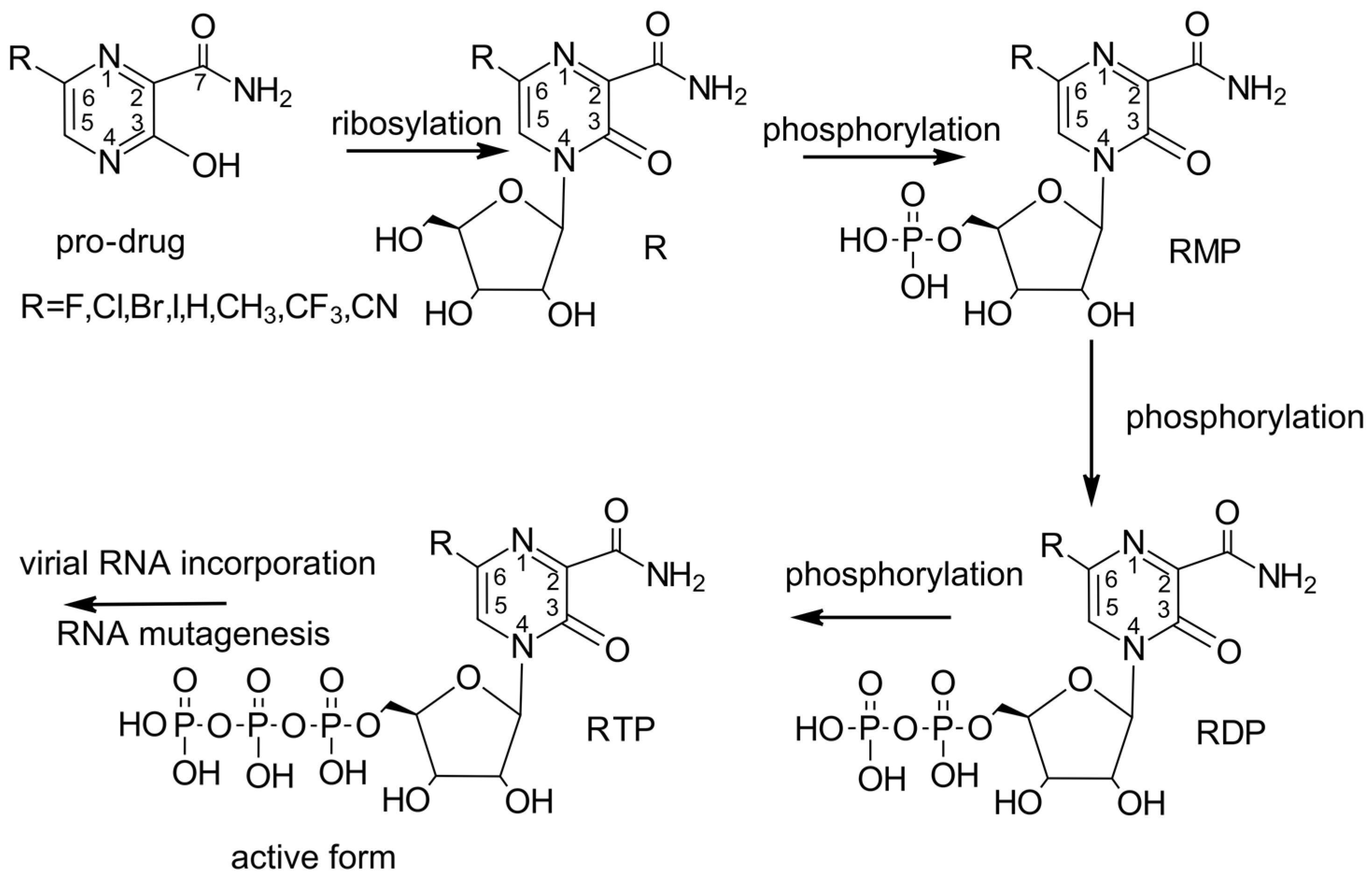
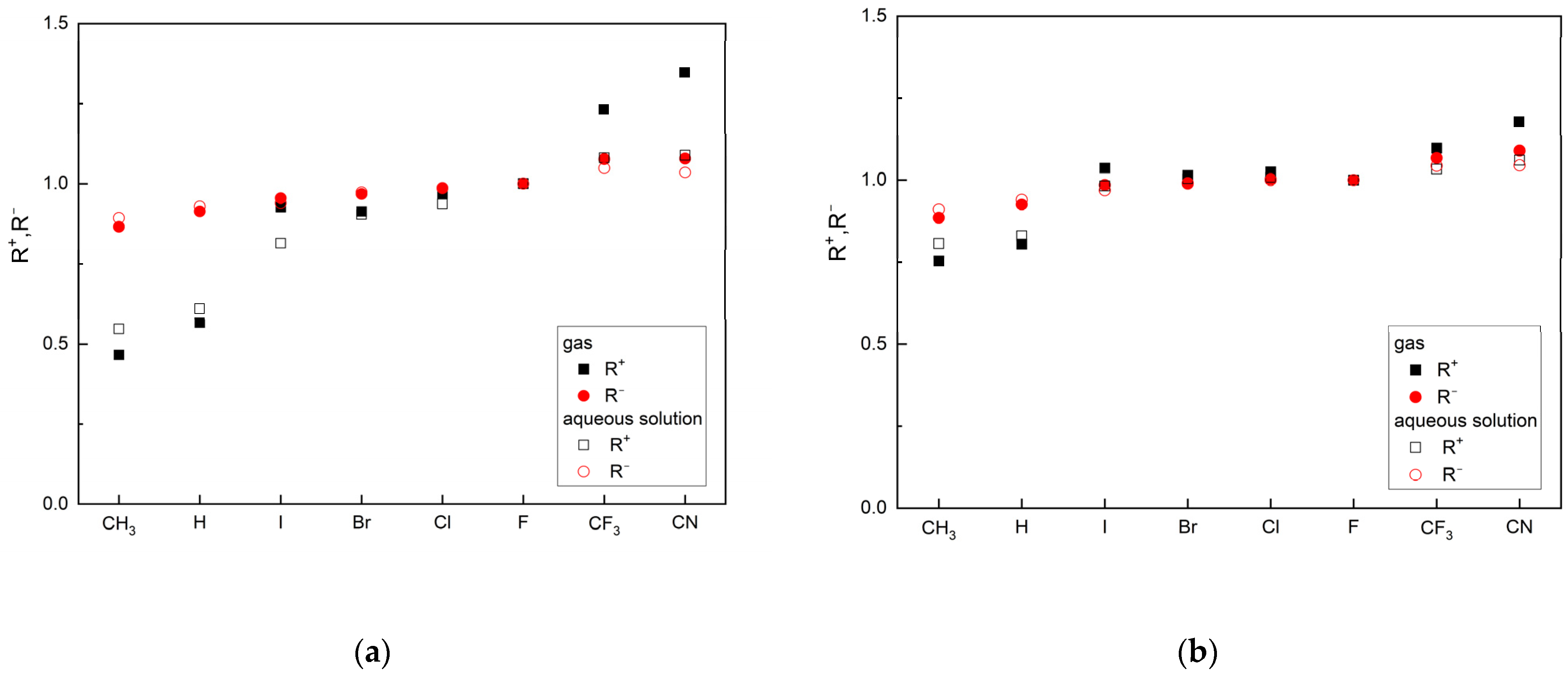
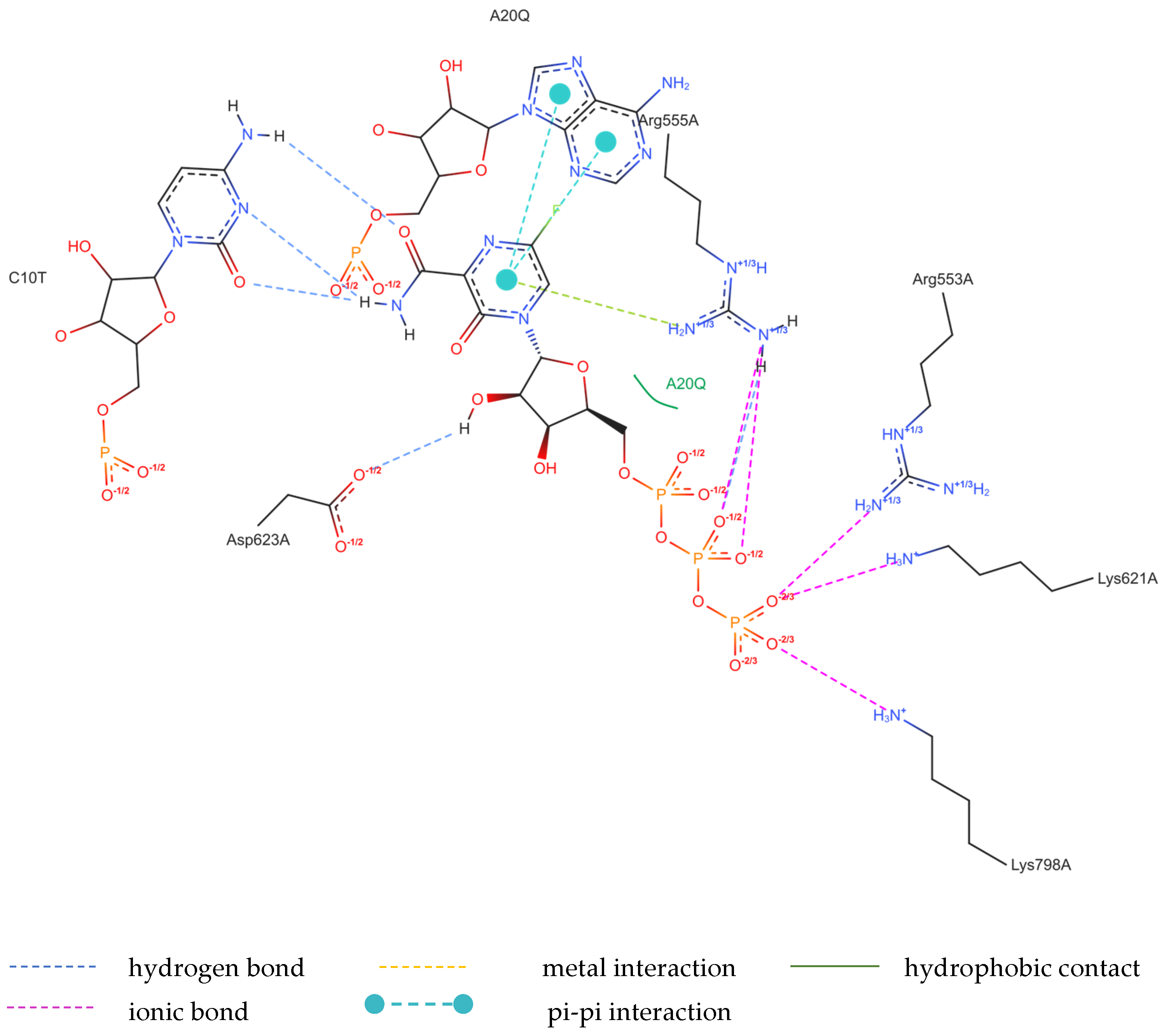
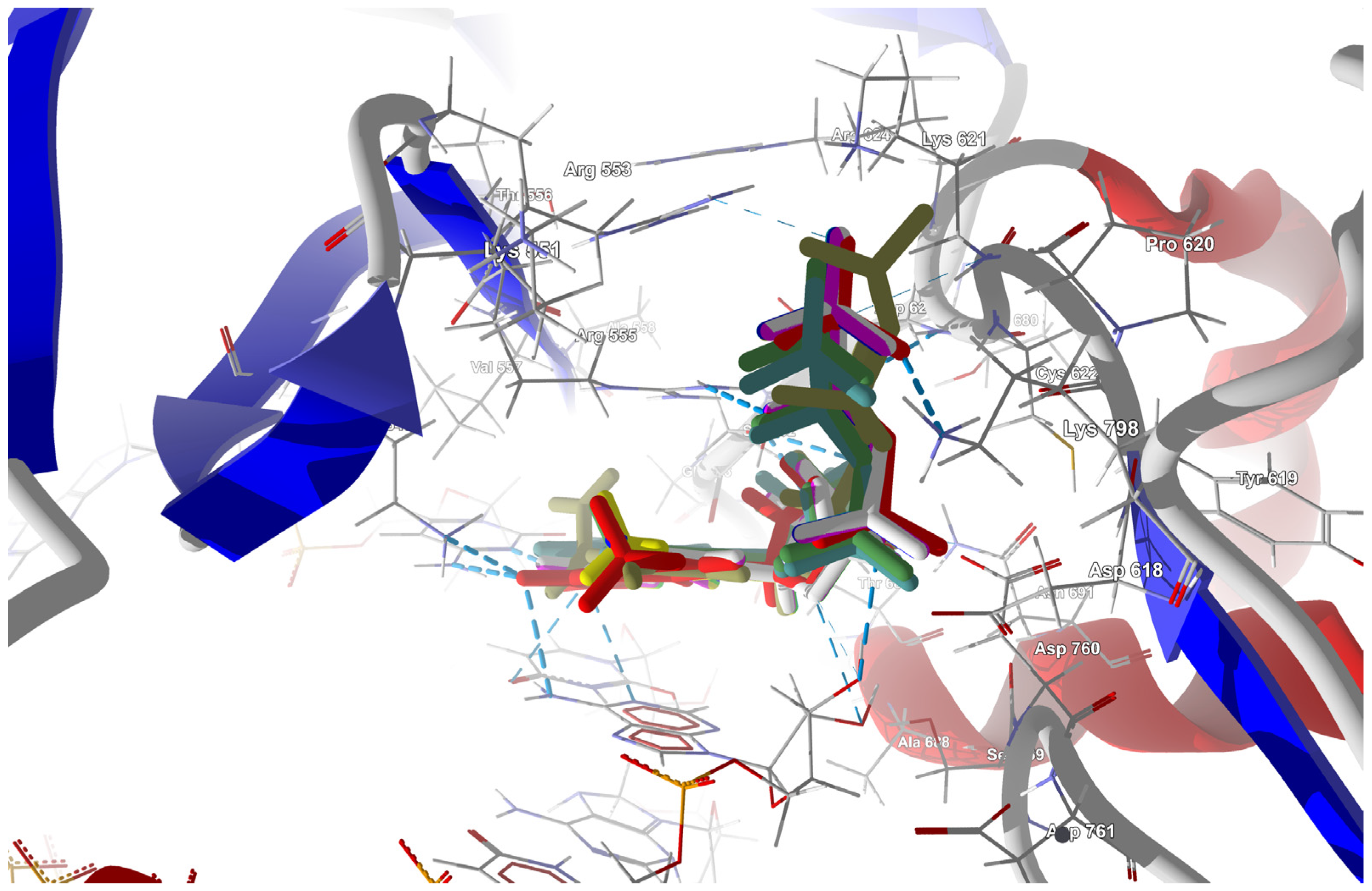
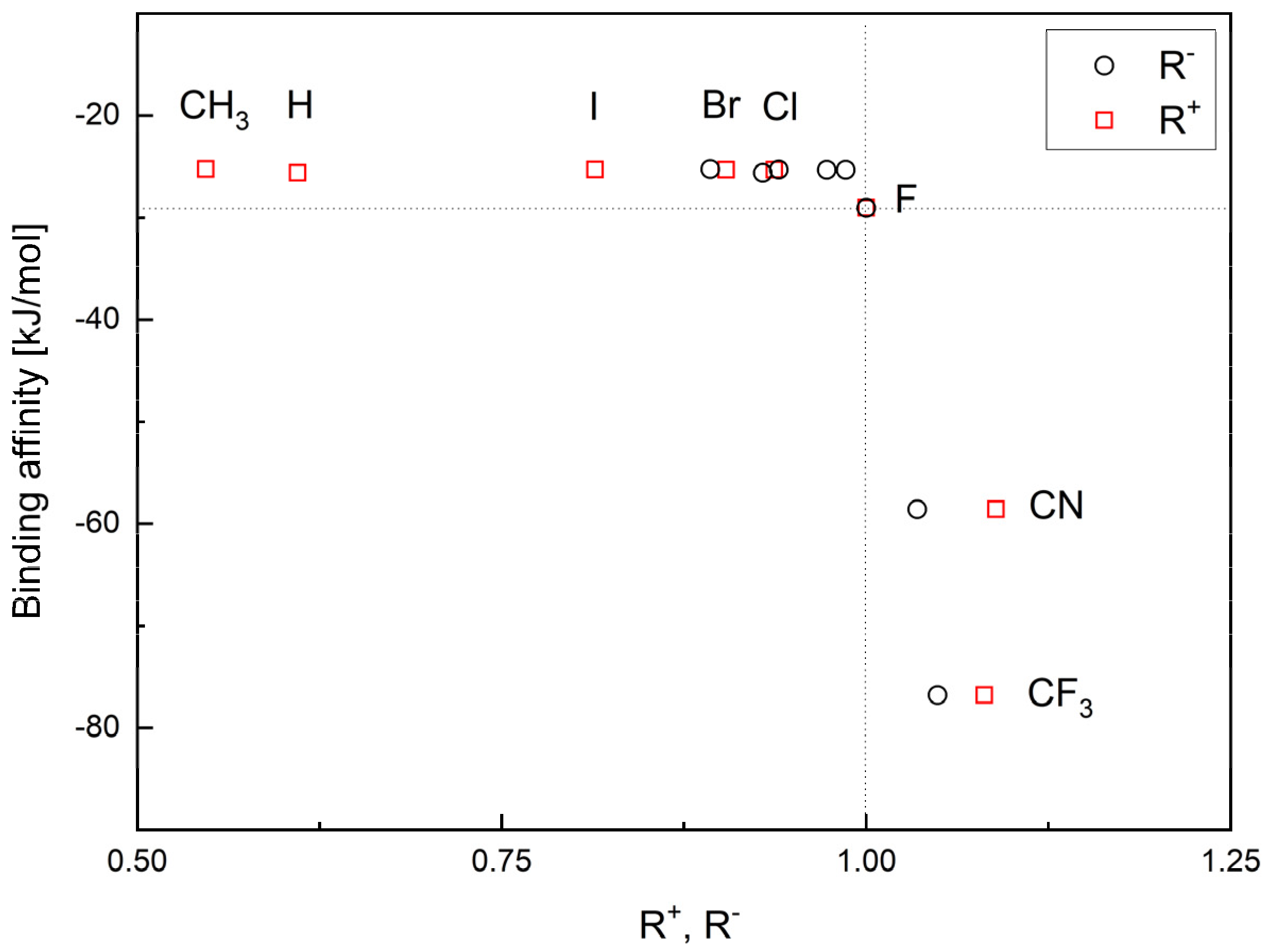



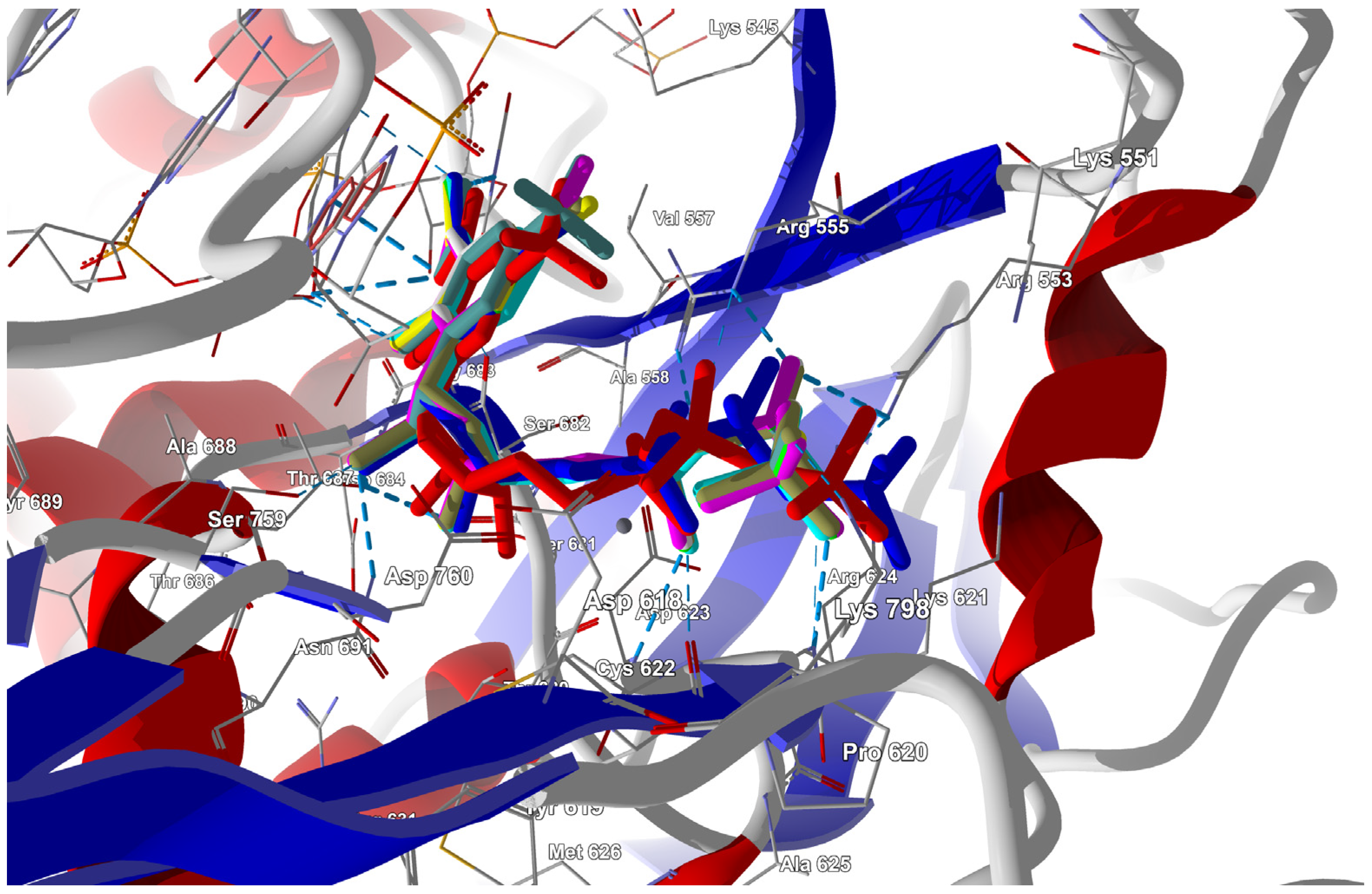
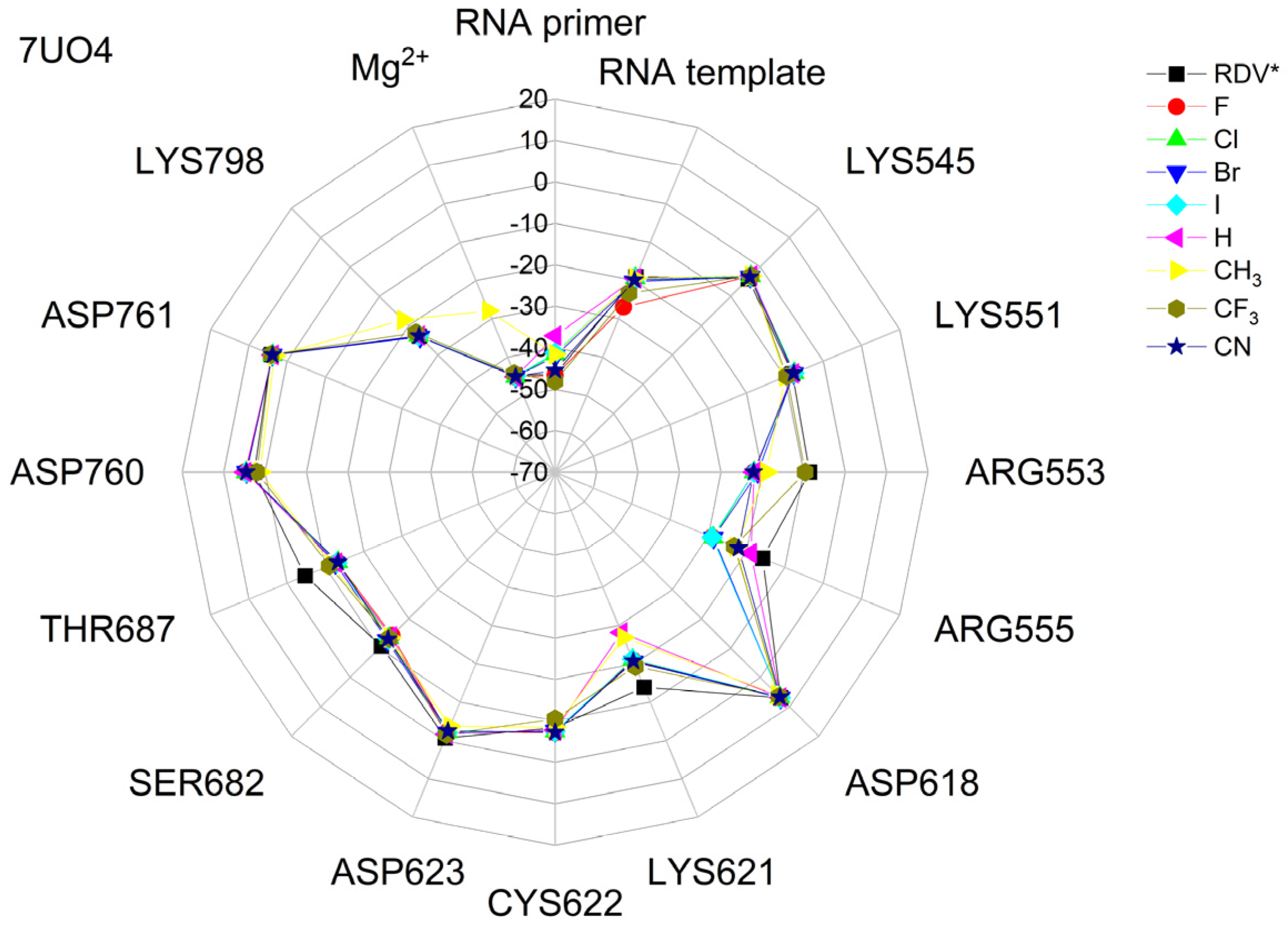
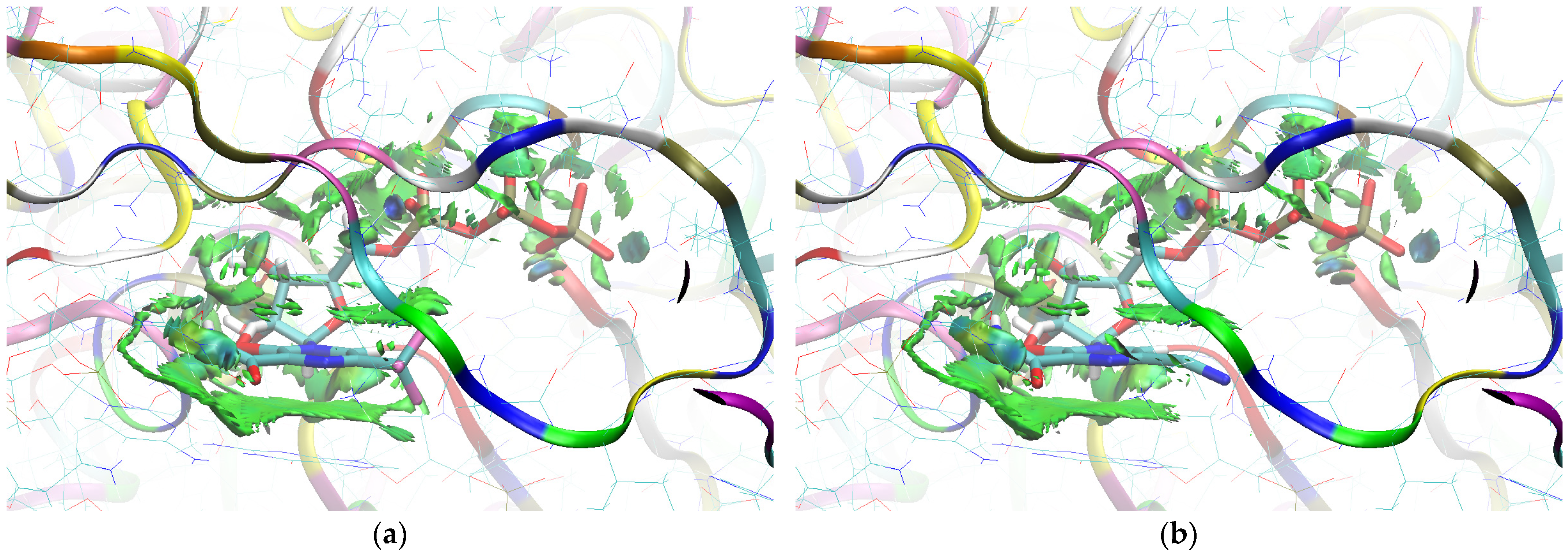
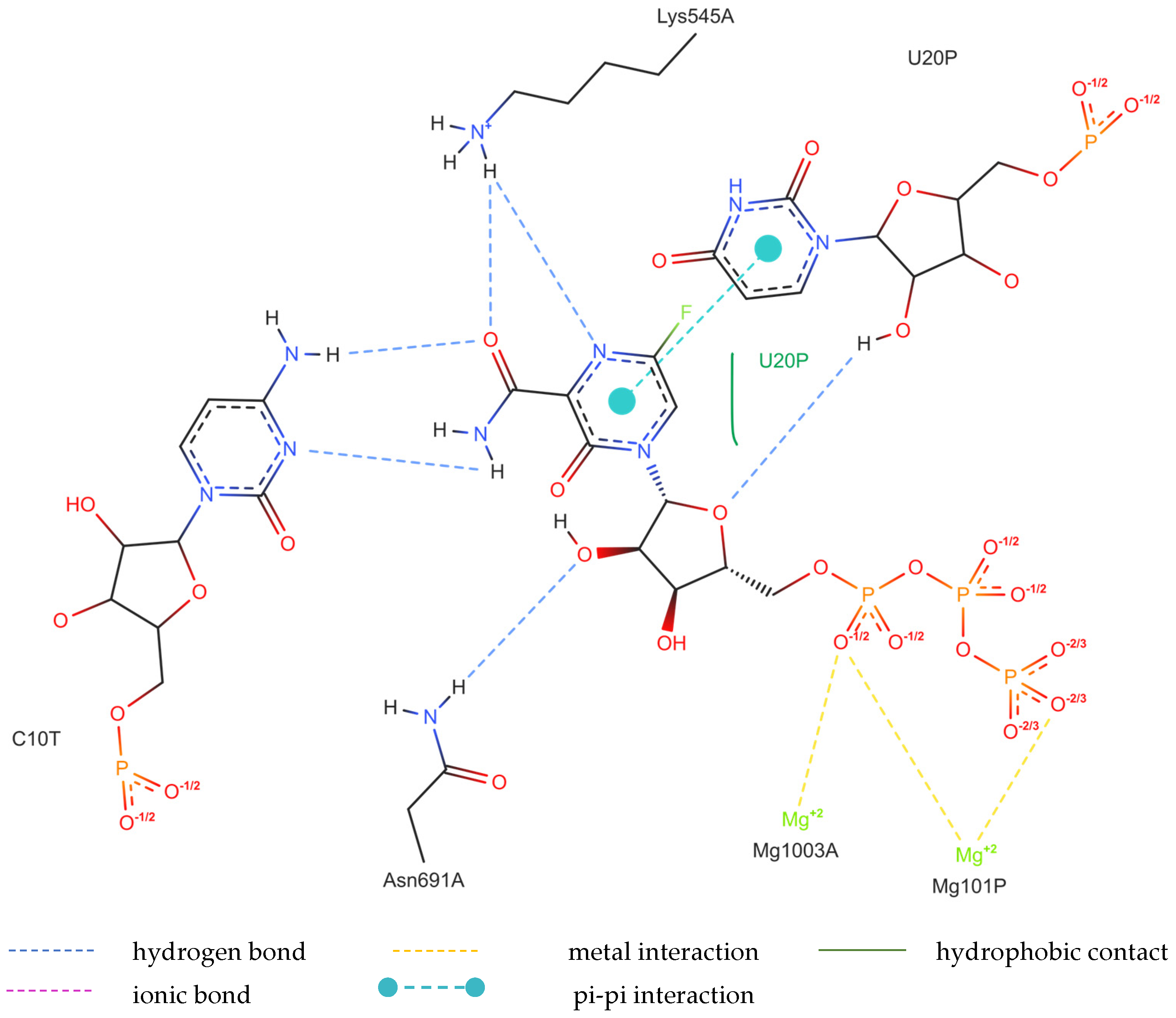
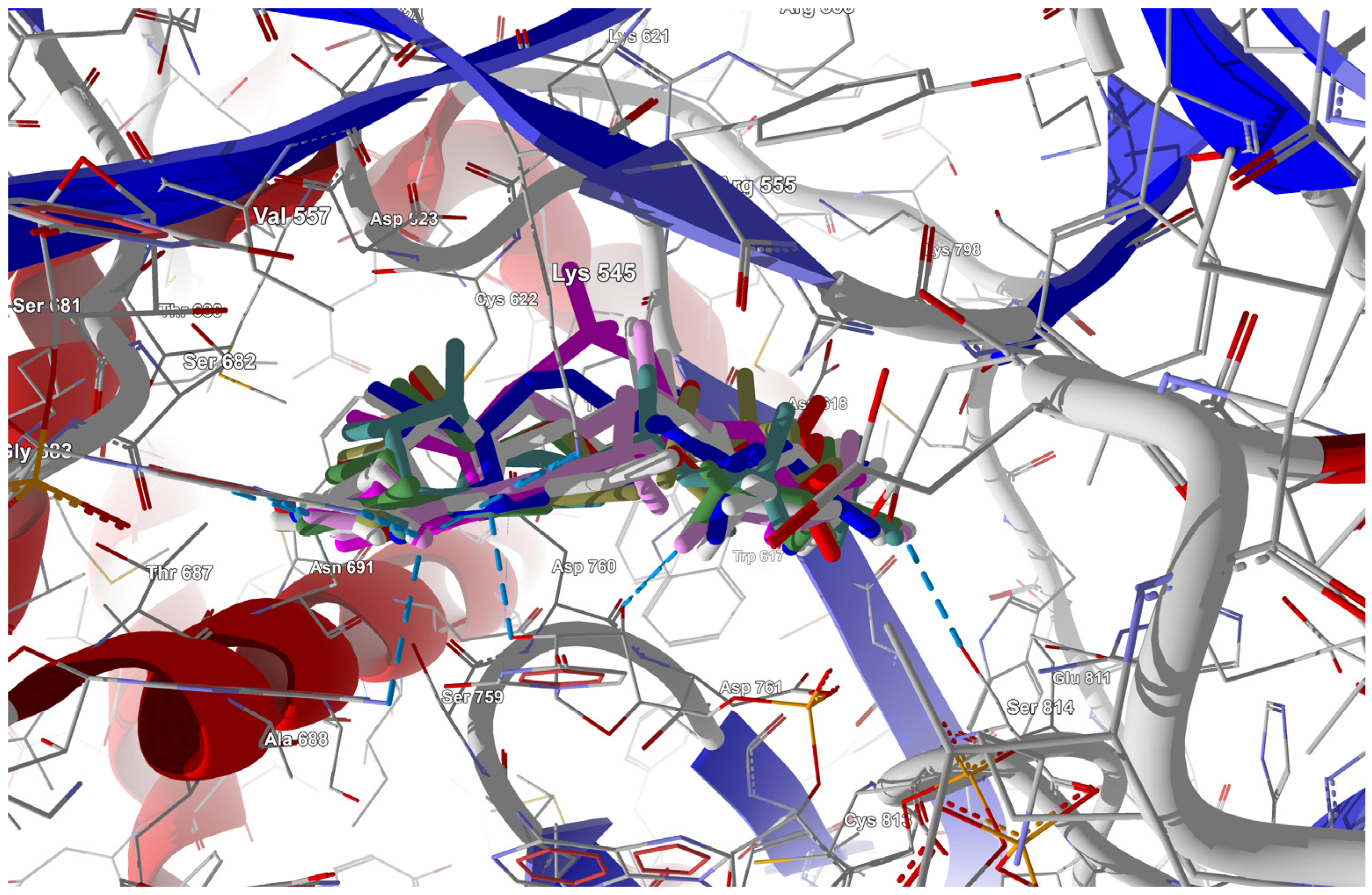



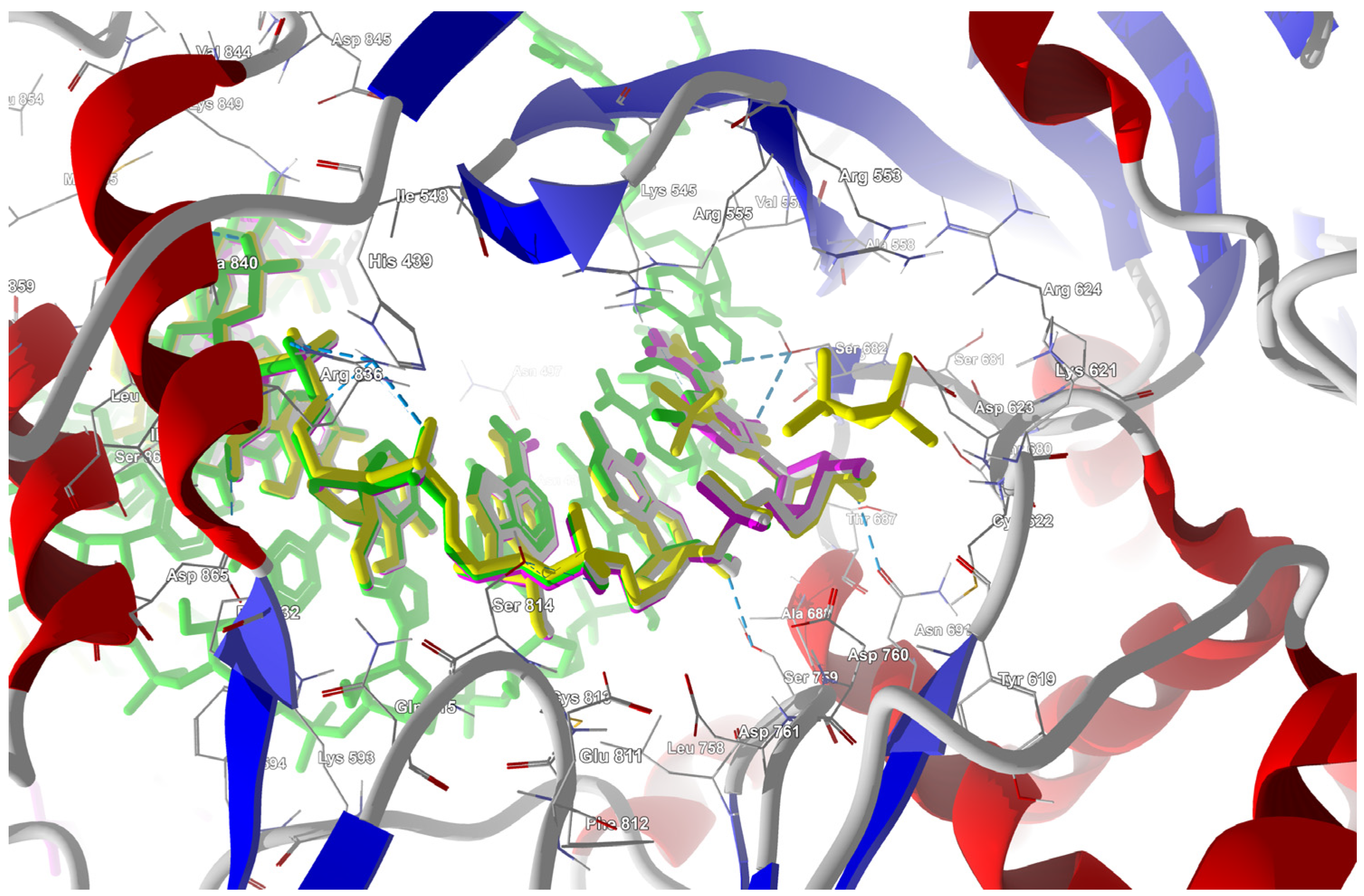


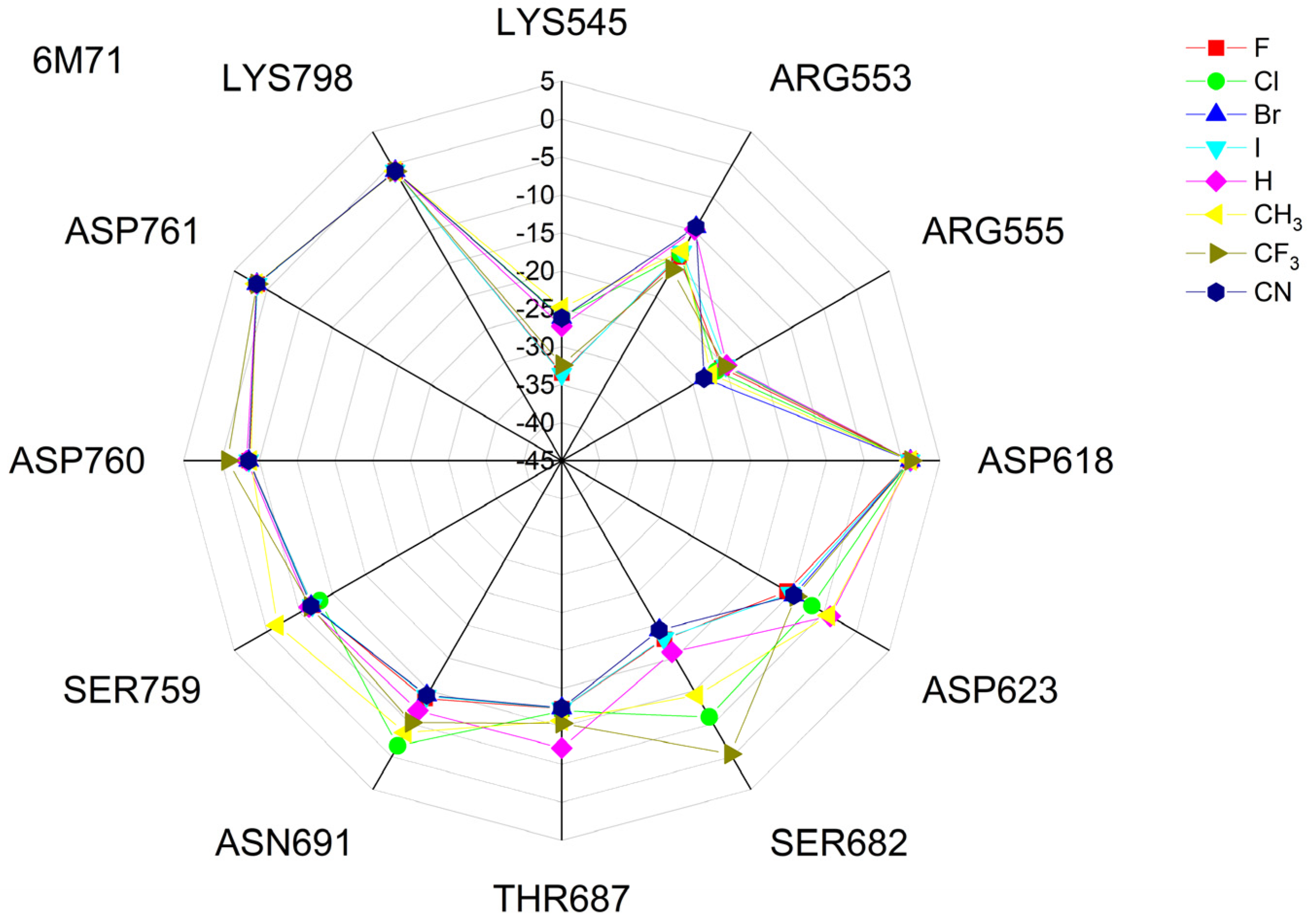
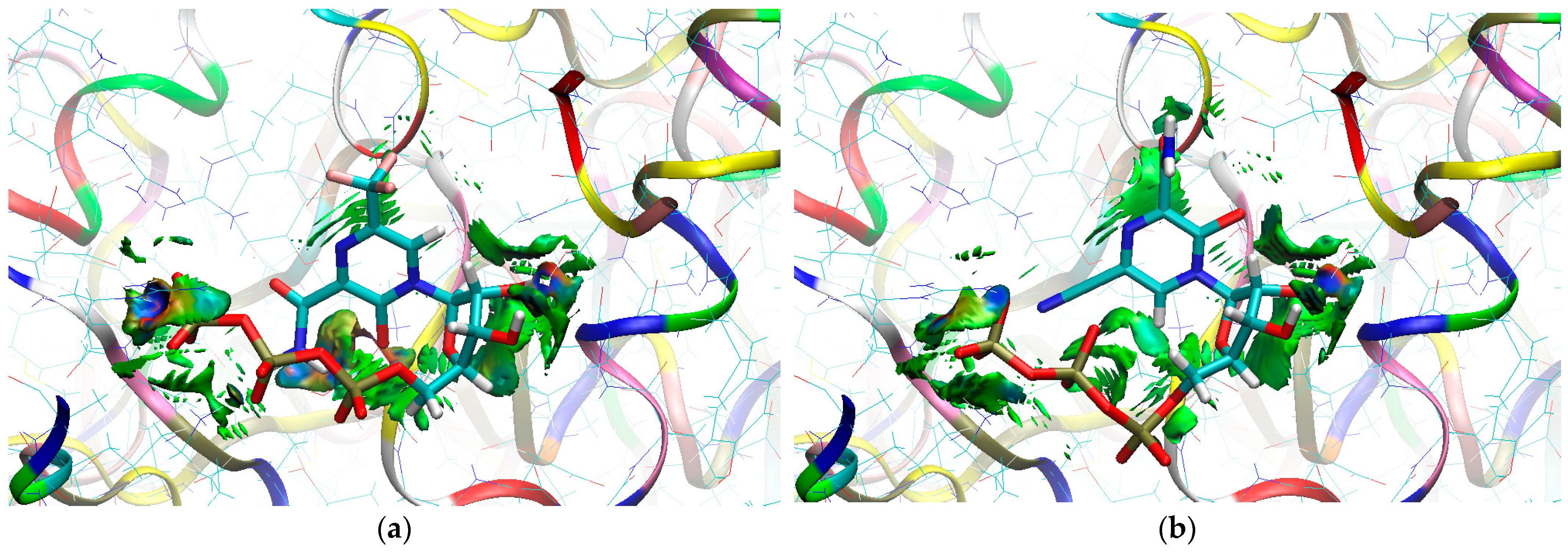

| R | MW | LogP * | LogP ** | Solubility (SILICOS-IT) | Abbot’s Bioavailability | TPSA [A2] | SAS | GI | Lead-likeness (Lipinski, Egan, Veber) |
|---|---|---|---|---|---|---|---|---|---|
| H | 139.11 | −0.65 | −1.539 | Soluble | 0.55 | 88.84 | 1.73 | High | Yes |
| F (FVP) | 157.1 | −0.27 | −0.934 | Soluble | 0.55 | 88.84 | 2.08 | High | Yes |
| Cl | 173.56 | −0.05 | −0.472 | Soluble | 0.55 | 88.84 | 2.07 | High | Yes |
| Br | 218.01 | 0.04 | −0.293 | Soluble | 0.55 | 88.84 | 2.12 | High | Yes |
| I | 265.01 | 0.06 | −0.313 | Soluble | 0.55 | 88.84 | 2.43 | High | Yes |
| CF3 | 207.11 | 0.52 | −0.142 | Soluble | 0.55 | 88.84 | 2.03 | High | Yes |
| CH3 | 153.14 | −0.31 | −0.982 | Soluble | 0.55 | 88.84 | 1.88 | High | Yes |
| CN | 164.12 | −0.83 | −0.878 | Soluble | 0.55 | 112.63 | 2.10 | High | Yes |
| MOL | 329.31 | −0.89 | −0.402 | Soluble | 0.55 | 143.14 | 4.49 | Low | No; 1 violation (MW > 300) |
| RVD | 602.23 | 0.52 | 1.961 | Moderately soluble | 0.17 | 203.55 | 6.43 | Low | No; 2 violations (MW > 350, rotors > 7, TPSA > 140) |
| NMVr | 499.24 | 1.64 | 2.013 | Moderately soluble | 0.55 | 131.4 | 4.82 | High | No; 1 violation (rotors > 10, MW > 350) |
| RTV | 720.94 | 5.04 | 4.5 | Insoluble | 0.17 | 202.26 | 6.45 | Low | No, 3 violations (MW > 350, XLOGP3 > 3.5, rotors > 7) |
| Optimal values | <500 | 1 < logP < 4 | Soluble | 1.0 | <140 | <10 | High | Yes | |
| R | BBB, PAINS | BRENK | P-gp | CYP1A2, CYP2C19, CYP2C9, CYP2D6, CYP3A4 | Carcinogenicity | Genotoxic Carcinogenicity/Mutagenicity | AMES | LD50 Rat | H-HT | DILI |
|---|---|---|---|---|---|---|---|---|---|---|
| H | No | No | No | No | 0.134 | 0 | 0.022 | 0.269 | 0.177 | 0.956 |
| F (FVP) | No | No | No | No | 0.23 | 0 | 0.031 | 0.522 | 0.833 | 0.935 |
| Cl | No | No | No | No | 0.501 | 0 | 0.027 | 0.636 | 0.21 | 0.92 |
| Br | No | No | No | No | 0.708 | 0 | 0.055 | 0.962 | 0.082 | 0.835 |
| I | No | No | No | No | 0.169 | 0 | 0.032 | 0.487 | 0.101 | 0.603 |
| CF3 | No | No | No | No | 0.14 | 0 | 0.326 | 0.967 | 0.491 | 0.948 |
| CH3 | No | No | No | No | 0.158 | 0 | 0.018 | 0.364 | 0.331 | 0.893 |
| CN | No | No | No | No | 0.168 | 0 | 0.028 | 0.434 | 0.893 | 0.941 |
| MOL | No | No | No | No | 0.303 | 4 rules violation | 0.512 | 0.021 | 0.486 | 0.976 |
| RVD | No | 1 alert (phosphorus) | Yes | No CYP3A4 Yes | 0.314 | 5 rules violation | 0.822 | 0.719 | 0.257 | 0.946 |
| NMVr | No | No | Yes | No CYP3A4 Yes | 0.119 | 0 | 0.003 | 0.962 | 0.293 | 0.556 |
| RTV | No | No | Yes | No CYP3A4 Yes | 0.021 | 1 rule violation | 0.023 | 0.245 | 0.965 | 0.978 |
| Optimal values | No | No | Yes | No | 0 | 0 | 0 | 0 | 0 | 0 |
| R * | HOMO [eV] | LUMO [eV] | Gap [eV] | Χ [eV] | η [eV] | ω [eV] | S [1/eV] | ω+ [eV] | ω− [eV] | Δω [eV] | ΔNmax [−] | R+ [−] | R− [−] |
|---|---|---|---|---|---|---|---|---|---|---|---|---|---|
| single molecule (gas) | |||||||||||||
| H | −9.703 | 1.672 | 11.375 | 4.016 | 5.688 | 1.418 | 0.176 | 4.136 | 0.121 | 4.257 | 0.706 | 0.567 | 0.914 |
| F | −9.864 | 1.237 | 11.101 | 4.313 | 5.550 | 1.676 | 0.180 | 4.526 | 0.213 | 4.740 | 0.777 | 1.000 | 1.000 |
| Cl | −9.763 | 1.245 | 11.007 | 4.259 | 5.504 | 1.648 | 0.182 | 4.465 | 0.206 | 4.672 | 0.774 | 0.968 | 0.987 |
| Br | −9.641 | 1.270 | 10.911 | 4.186 | 5.455 | 1.606 | 0.183 | 4.380 | 0.195 | 4.575 | 0.767 | 0.914 | 0.968 |
| I | −9.465 | 1.218 | 10.683 | 4.124 | 5.341 | 1.592 | 0.187 | 4.321 | 0.198 | 4.519 | 0.772 | 0.927 | 0.955 |
| CF3 | −10.366 | 1.138 | 11.505 | 4.614 | 5.752 | 1.851 | 0.174 | 4.877 | 0.263 | 5.139 | 0.802 | 1.232 | 1.077 |
| CH3 | −9.366 | 1.723 | 11.090 | 3.822 | 5.545 | 1.317 | 0.180 | 3.921 | 0.099 | 4.020 | 0.689 | 0.466 | 0.866 |
| CN | −10.201 | 1.008 | 11.209 | 4.597 | 5.604 | 1.885 | 0.178 | 4.884 | 0.287 | 5.171 | 0.820 | 1.348 | 1.079 |
| aqueous solution, pH = 7 | |||||||||||||
| H | −9.582 | 1.671 | 11.254 | 3.955 | 5.627 | 1.390 | 0.178 | 4.071 | 0.116 | 4.187 | 0.703 | 0.610 | 0.929 |
| F | −9.686 | 1.303 | 10.989 | 4.192 | 5.494 | 1.599 | 0.182 | 4.382 | 0.190 | 4.572 | 0.763 | 1.000 | 1.000 |
| Cl | −9.626 | 1.345 | 10.971 | 4.140 | 5.486 | 1.562 | 0.182 | 4.318 | 0.178 | 4.496 | 0.755 | 0.937 | 0.986 |
| Br | −9.544 | 1.358 | 10.902 | 4.093 | 5.451 | 1.537 | 0.183 | 4.265 | 0.172 | 4.436 | 0.751 | 0.904 | 0.973 |
| I | −9.315 | 1.390 | 10.705 | 3.962 | 5.352 | 1.467 | 0.187 | 4.117 | 0.155 | 4.271 | 0.740 | 0.814 | 0.940 |
| CF3 | −10.104 | 1.326 | 11.430 | 4.389 | 5.715 | 1.685 | 0.175 | 4.594 | 0.205 | 4.800 | 0.768 | 1.081 | 1.049 |
| CH3 | −9.291 | 1.674 | 10.965 | 3.809 | 5.482 | 1.323 | 0.182 | 3.912 | 0.104 | 4.016 | 0.695 | 0.547 | 0.893 |
| CN | −9.937 | 1.281 | 11.169 | 4.328 | 5.609 | 1.670 | 0.178 | 4.535 | 0.207 | 4.742 | 0.772 | 1.089 | 1.035 |
| R * | HOMO [eV] | LUMO [eV] | Gap [eV] | Χ [eV] | η [eV] | ω [eV] | S [1/eV] | ω+ [eV] | ω− [eV] | Δω [eV] | ΔNmax [−] | R+ [−] | R− [−] |
|---|---|---|---|---|---|---|---|---|---|---|---|---|---|
| single molecule (gas) | |||||||||||||
| H | −8.750 | −1.080 | 7.669 | 4.915 | 3.835 | 3.150 | 0.261 | 6.087 | 1.172 | 7.258 | 1.282 | 0.805 | 0.926 |
| F | −8.799 | −1.432 | 7.367 | 5.115 | 3.684 | 3.552 | 0.271 | 6.570 | 1.455 | 8.025 | 1.389 | 1.000 | 1.000 |
| Cl | −8.722 | −1.477 | 7.246 | 5.100 | 3.623 | 3.589 | 0.276 | 6.592 | 1.492 | 8.084 | 1.408 | 1.026 | 1.003 |
| Br | −8.574 | −1.463 | 7.112 | 5.018 | 3.556 | 3.541 | 0.281 | 6.495 | 1.477 | 7.972 | 1.411 | 1.015 | 0.989 |
| I | −8.422 | −1.501 | 6.920 | 4.961 | 3.460 | 3.557 | 0.289 | 6.470 | 1.509 | 7.979 | 1.434 | 1.037 | 0.985 |
| CF3 | −9.258 | −1.582 | 7.676 | 5.420 | 3.838 | 3.827 | 0.261 | 7.017 | 1.597 | 8.614 | 1.412 | 1.098 | 1.068 |
| CH3 | −8.434 | −0.997 | 7.437 | 4.715 | 3.718 | 2.990 | 0.269 | 5.812 | 1.097 | 6.909 | 1.268 | 0.754 | 0.885 |
| CN | −9.188 | −1.711 | 7.478 | 5.449 | 3.739 | 3.971 | 0.267 | 7.163 | 1.714 | 8.877 | 1.457 | 1.178 | 1.090 |
| aqueous solution, pH = 7 | |||||||||||||
| H | −8.675 | −1.099 | 7.576 | 4.887 | 3.788 | 3.152 | 0.264 | 6.069 | 1.182 | 7.252 | 1.290 | 0.830 | 0.940 |
| F | −8.668 | −1.400 | 7.268 | 5.034 | 3.634 | 3.486 | 0.275 | 6.458 | 1.424 | 7.881 | 1.385 | 1.000 | 1.000 |
| Cl | −8.634 | −1.413 | 7.220 | 5.023 | 3.610 | 3.495 | 0.277 | 6.458 | 1.435 | 7.893 | 1.391 | 1.008 | 1.000 |
| Br | −8.533 | −1.410 | 7.122 | 4.972 | 3.561 | 3.470 | 0.281 | 6.401 | 1.430 | 7.831 | 1.396 | 1.004 | 0.991 |
| I | −8.343 | −1.380 | 6.963 | 4.861 | 3.482 | 3.394 | 0.287 | 6.260 | 1.398 | 7.658 | 1.396 | 0.982 | 0.969 |
| CF3 | −9.098 | −1.443 | 7.655 | 5.271 | 3.828 | 3.629 | 0.261 | 6.743 | 1.472 | 8.215 | 1.377 | 1.034 | 1.044 |
| CH3 | −8.402 | −1.069 | 7.333 | 4.735 | 3.666 | 3.058 | 0.273 | 5.884 | 1.149 | 7.033 | 1.292 | 0.807 | 0.911 |
| CN | −8.977 | −1.492 | 7.485 | 5.235 | 3.743 | 3.661 | 0.267 | 6.746 | 1.511 | 8.257 | 1.399 | 1.061 | 1.045 |
| FVP | CF3 | CN | ||||
|---|---|---|---|---|---|---|
| 1 | N(4) | 3.531 | N(4) | 3.545 | N(4) | 3.537 |
| 2 | C(2) | 3.964 | C(2) | 4.279 | C(2) | 4.251 |
| 3 | C(6) | 5.151 | C(6) | 5.715 | C(6) | 5.897 |
| 4 | N(1) | 3.695 | N(1) | 3.783 | N(1) | 3.711 |
| 5 | C(2) | 5.124 | C(2) | 5.266 | C(2) | 5.048 |
| 6 | C(7) | 5.294 | C(7) | 5.453 | C(7) | 5.390 |
| 7 | N(7) | 3.037 | N(7) | 3.034 | N(7) | 3.049 |
| 8 | =O | 2.293 | =O | 2.291 | =O | 2.284 |
| 9 | C(3) | 5.154 | C(3) | 5.378 | C(3) | 5.277 |
| 10 | OH | 2.492 | OH | 2.503 | OH | 2.502 |
| 11 | F | 1.495 | C | 5.128 | C | 5.164 |
| 11a | - | - | F | 1.555 | N | 2.684 |
| 11b | - | - | F | 1.511 | - | - |
| 11c | - | - | F | 1.510 | - | - |
| 12 | H | 0.795 | H | 0.810 | H | 0.796 |
| 13 | H | 0.858 | H | 0.854 | H | 0.852 |
| 14 | H(OH) | 0.896 | H(OH) | 0.895 | H(OH) | 0.899 |
| 15 | H | 1.013 | H | 1.007 | H | 0.998 |
| No. | Residue Chain | Residue Name | H⋯A Distance [Å] | D⋯A Distance [Å] | <DHA | Type | Donor | Acceptor | Moiety |
|---|---|---|---|---|---|---|---|---|---|
| 1 | 621A | LYS | 3.30 | 4.05 | 133.53 | D | 4327 [Nam] | 8910 [O3] | Phosphate |
| 2 | 622A | CYS | 3.03 | 3.63 | 120.57 | D | 4336 [Nam] | 8913 [O2] | Phosphate |
| 3 | 623A | ASP | 2.60 | 3.46 | 147.96 | A | 8902 [O3] | 4349 [O2] | Ribosyl |
| 4 | 623A | ASP | 2.70 | 3.59 | 153.00 | A | 8903 [O3] | 4349 [O2] | Ribosyl |
| 5 | 623A | ASP | 2.82 | 3.74 | 156.06 | D | 4342 [Nam] | 8913 [O2] | Phosphate |
| 6 | 682A | SER | 2.09 | 2.99 | 150.84 | A | 8898 [Nam] | 4792 [O2] | Pyridazine |
| 7 | 691A | ASN | 2.72 | 3.19 | 109.79 | D | 4855 [Nam] | 8902 [O3] | Ribosyl |
| 8 | 760A | ASP | 3.00 | 3.77 | 140.59 | D | 5420 [O3] | 8901 [O3] | Ribosyl |
| No. | Residue Chain | Residue Name | Distance [Å] | Ligand Moiety | Interaction Type |
|---|---|---|---|---|---|
| 1 | 555A | ARG | 4.12 | Aromatic | π-cation |
| 2 | 553A | ARG | 5.42 | Phosphate | ionic/salt bridge |
| 3 | 553A | ARG | 4.78 | Phosphate | ionic/salt bridge |
| 4 | 555A | ARG | 5.05 | Phosphate | ionic/salt bridge |
| 5 | 621A | LYS | 4.36 | Phosphate | ionic/salt bridge |
| 6 | 798A | LYS | 5.32 | Phosphate | ionic/salt bridge |
| 7 | 798A | LYS | 5.44 | Phosphate | ionic/salt bridge |
| 8 | 798A | LYS | 3.73 | Phosphate | ionic/salt bridge |
| 9 | Mg2+ | 6.94 | Phosphate | metal |
| Parameter | FVP * | F | Cl | Br | I | H | CH3 | CF3 | CN |
|---|---|---|---|---|---|---|---|---|---|
| binding score **, kcal/mol | - | −6.92 | −6.95 | −6.94 | −6.90 | −6.54 | −6.96 | −10.51 | −11.58 |
| docking score, kcal/mol | - | −125.466 | −126.032 | −125.752 | −125.343 | −118.565 | −126.244 | −190.616 | −209.746 |
| protein–ligand, kcal/mol | −112.71 | −132.906 | −134.130 | −134.054 | −134.117 | −130.160 | −134.035 | −135.452 | −167.177 |
| protein–ligand hydrogen bonds, kcal/mol | −13.545 | −11.008 | −11.438 | −11.455 | −11.444 | −11.005 | −11.453 | −13.023 | −12.502 |
| cofactor-RNA template/primer–ligand, kcal/mol | −54.877 | −56.192 | −54.984 | −54.854 | −54.579 | −54.348 | −59.124 | −60.590 | −55.773 |
| binding affinity, kJ/mol | −24.66 | −29.05 | −25.31 | −25.31 | −25.30 | −25.60 | −25.26 | −76.80 | −58.57 |
| Parameter | Ordering |
|---|---|
| docking score | CN > CF3 > CH3 > Cl > Br > I > H > F |
| total energy of binding | CN > CF3 > Cl > I > CH3 > Br > H > F |
| hydrogen bonds linking the ligand to the protein | CF3 > CN > Br > CH3 > I > Cl > F > H |
| binding of the ligand to the RNA template | CF3 > H > F > CN > Br > Cl > I > CH3 |
| binding of the ligand to the RNA primer | CF3 > F > CH3 > Cl > H > Br > I > CN |
| binding of the ligand to both the RNA template and RNA primer | CF3 > F > CH3 > Cl > Br > H > I > CN |
| binding of the ligand to magnesium ion | CN > CF3 > H ≅ F > Br > I > CH3 > Cl |
| binding affinity | CF3 > CN > F > H > Cl ≅ Br > I > CH3 |
| R | The Entire Complex | Protein Residues | Mg2+, Zn2+, RNA Template/Primer | ||||||
|---|---|---|---|---|---|---|---|---|---|
| Euclidian | Manhattan | Additive | Euclidian | Manhattan | Additive | Euclidian | Manhattan | Additive | |
| H | 1.567 | 0.647 | 0.240 | 1.578 | 0.627 | 0.242 | 1.407 | 0.934 | 0.203 |
| Cl | 1.581 | 0.636 | 0.285 | 1.551 | 0.934 | 0.203 | 1.551 | 0.588 | 0.289 |
| Br | 1.576 | 0.635 | 0.283 | 1.549 | 0.589 | 0.289 | 1.919 | 1.294 | 0.199 |
| I | 1.566 | 0.631 | 0.278 | 1.549 | 0.590 | 0.288 | 1.791 | 1.228 | 0.131 |
| CF3 | 1.877 | 0.756 | 0.378 | 1.718 | 0.691 | 0.310 | 3.426 | 1.696 | 1.370 |
| CH3 | 1.590 | 0.640 | 0.288 | 1.550 | 0.588 | 0.288 | 2.091 | 1.384 | 0.284 |
| CN | 2.845 | 1.008 | 0.661 | 2.922 | 1.008 | 0.731 | 1.286 | 1.005 | −0.352 |
| FVP-RTP * | 1.585 | 0.636 | 0.299 | 1.529 | 0.587 | 0.279 | 2.234 | 1.336 | 0.585 |
| R | The Entire Complex (Selected Residues, Mg2+, Zn2+, RNA Template, and RNA Primer) | Selected Residues (555, 798, 621, 553, 682, 545, 691, 622, 623, 760, 761, and 618) | ||||
|---|---|---|---|---|---|---|
| Euclidian | Manhattan | Additive | Euclidian | Manhattan | Additive | |
| H | 1.492 | 0.480 | 0.213 | 1.498 | 0.449 | 0.214 |
| Cl | 1.523 | 0.473 | 0.273 | 1.488 | 0.934 | 0.203 |
| Br | 1.517 | 0.472 | 0.269 | 1.485 | 0.415 | 0.274 |
| I | 1.507 | 0.469 | 0.265 | 1.486 | 0.416 | 0.274 |
| CF3 | 1.803 | 0.577 | 0.377 | 1.632 | 0.500 | 0.308 |
| CH3 | 1.533 | 0.477 | 0.276 | 1.486 | 0.414 | 0.275 |
| CN | 2.729 | 0.737 | 0.634 | 2.801 | 0.719 | 0.703 |
| FVP-RTP * | 1.512 | 0.470 | 0.274 | 1.448 | 0.409 | 0.252 |
| Residue | FVP-RTP * | F | Cl | Br | I | H | CH3 | CF3 | CN |
|---|---|---|---|---|---|---|---|---|---|
| RNA primer | −41.019 | −45.808 | −44.858 | −44.732 | −44.396 | −43.848 | −45.166 | −48.652 | −42.647 |
| RNA template | −13.292 | −11.988 | −11.262 | −11.263 | −11.257 | −12.039 | −11.254 | −16.309 | −11.66 |
| LYS545 | −5.379 | −5.136 | −4.984 | −4.986 | −4.991 | −4.686 | −4.981 | −9.728 | −5.070 |
| ARG553 | −15.047 | −18.025 | −18.809 | −18.756 | −18.773 | −18.002 | −18.773 | −16.868 | −17.259 |
| ARG555 | −31.286 | −30.126 | −30.431 | −30.376 | −30.360 | −27.792 | −30.436 | −32.469 | −31.030 |
| ASP618 | 14.767 | 17.189 | 15.055 | 15.158 | 15.186 | 17.225 | 15.116 | 11.267 | 4.697 |
| LYS621 | −20.662 | −30.887 | −30.866 | −30.872 | −30.869 | −30.827 | −30.880 | −31.682 | −40.246 |
| CYS622 | −4.298 | −6.501 | −6.469 | −6.472 | −6.462 | −6.520 | −6.463 | −6.449 | −7.593 |
| ASP623 | −4.074 | −4.861 | −5.687 | −5.657 | −5.637 | −4.869 | −5.661 | −5.553 | −7.966 |
| SER682 | −6.868 | −10.886 | −11.051 | −11.051 | −11.059 | −10.859 | −11.041 | −10.147 | −9.894 |
| ASN691 | −4.639 | −5.911 | −6.279 | −6.276 | −6.266 | −5.905 | −6.276 | −2.873 | −6.288 |
| SER759 | −0.740 | −1.690 | −1.857 | −1.861 | −1.852 | −1.686 | −1.861 | −0.752 | −1.061 |
| ASP760 | 2.617 | 0.655 | 1.806 | 1.776 | 1.699 | 0.570 | 1.786 | 5.699 | 2.603 |
| ASP761 | 4.659 | 4.242 | 4.203 | 4.206 | 4.204 | 4.240 | 4.206 | 4.363 | 3.125 |
| LYS798 | −23.722 | −21.897 | −20.299 | −20.352 | −20.363 | −21.910 | −20.329 | −21.657 | −29.618 |
| Mg2+ | −7.022 | −6.450 | −6.306 | −6.314 | −6.313 | −6.450 | −6.312 | −6.464 | −5.305 |
| cosine distance (total) ** | 1.0 | 0.988 | 0.985 | 0.985 | 0.985 | 0.985 | 0.985 | 0.985 | 0.956 |
| cosine distance (residues) ** | 1.0 | 0.980 | 0.977 | 0.977 | 0.977 | 0.975 | 0.977 | 0.974 | 0.939 |
| No. | Reside Chain | Residue Name | H⋯A Distance [Å] | D⋯A Distance [Å] | <DHA | Donor/Acceptor | Donor | Acceptor | Moiety |
|---|---|---|---|---|---|---|---|---|---|
| 1 | 621A | LYS | 3.17 | 4.09 | 155.61 | D | 4992 [Nam] | 12374 [O3] | Phosphate |
| 2 | 622A | CYS | 3.12 | 4.04 | 156.57 | D | 5001 [Nam] | 12373 [O3] | Phosphate |
| 3 | 623A | ASP | 2.64 | 3.21 | 117.47 | D | 5007 [Nam] | 12378 [O3] | Phosphate |
| 4 | 623A | ASP | 2.15 | 3.11 | 168.63 | A | 12,378 [O3] | 5014 [O−] | Phosphate |
| 5 | 687A | THR | 2.74 | 3.70 | 168.20 | A | 12,379 [O3] | 5489 [O3] | Phosphate |
| 6 | 691A | ASN | 2.00 | 2.80 | 136.69 | D | 5520 [Nam] | 12379 [O3] | Ribosyl |
| 7 | 759A | SER | 2.91 | 3.59 | 128.06 | D | 6082 [O3] | 12381 [N1] | Ribosyl |
| No. | Residue Chain | Residue Name | Distance [Å] | Ligand Moiety | Interaction Type |
|---|---|---|---|---|---|
| 1 | 551A | LYS | 5.08 | Phosphate | salt bridge |
| 2 | 798A | LYS | 3.58 | Phosphate | salt bridge |
| 3 | Mg2+ | 2.34 | Phosphate | metal | |
| 4 | Mg2+ | 2.82 | Phosphate | metal |
| RDV * | F | Cl | Br | I | H | CH3 | CF3 | CN | |
|---|---|---|---|---|---|---|---|---|---|
| Tanimoto binding fingerprint distance | 1.0 | 0.735 | 0.735 | 0.735 | 0.735 | 0.735 | 0.753 | 0.753 | 0.735 |
| binding score **, kcal/mol | - | −8.201 | −7.673 | −7.663 | −7.651 | −7.448 | −7.292 | −7.887 | −7.786 |
| docking score, kcal/mol | - | −251.895 | −235.698 | −235.415 | −235.02 | −228.801 | −223.990 | −242.268 | −239.205 |
| protein–ligand, total, kcal/mol | −114.144 | −156.685 | −155.140 | −153.131 | −155.108 | −154.503 | −155.543 | −158.402 | −155.860 |
| protein–ligand hydrogen bonds, kcal/mol | −6.768 | −26.465 | −24.459 | −22.111 | −24.378 | −25.941 | −18.922 | −22.176 | −23.164 |
| cofactor-RNA template/primer–ligand, total, kcal/mol | −57.037 (−7.328) | −55.375 (−23.783) | −50.282 (−15.983) | −53.411 (−14.170) | −53.411 (−14.055) | −45.374 (−15.276) | −59.404 (−15.487) | −53.785 (−10.571) | −54.901 (−15.961) |
| hydrogen bonds, total, kcal/mol | −13.439 | −26.484 | −23.114 | −22.107 | −22.250 | −22.756 | −18.649 | −18.649 | −22.189 |
| binding affinity, kJ/mol | - | −112.947 | −84.893 | −82.002 | −83.860 | −84.413 | −82.009 | −70.516 | −83.455 |
| Parameter | Ordering |
|---|---|
| docking score | F > CF3 > CN > Cl > Br > I > CH3 > H |
| total energy of binding | CF3 > F > CN > CH3 > Cl > I > H > Br |
| hydrogen bonds linking the ligand to the protein | F > H > Cl > I > CN > CF3 > Br > CH3 |
| binding of the ligand to the RNA template | F > CF3 > CN > Br > I > H > Cl > CH3 |
| binding of the ligand to the RNA primer | CF3 > F > CN > Br > CH3 > Cl > I > H |
| binding of the ligand to both the RNA template and RNA primer | F > CF3 > CN > Br > CH3 > Cl > I > H |
| binding of the ligand to magnesium ion | F > H > Cl > Br > CN > I > CF3 > CH3 |
| binding affinity | F > Cl > H > I > CN > CH3 > Br > CF3 |
| R | Complex | Protein | Mg2+, Zn2+, RNA Template/Primer | ||||||
|---|---|---|---|---|---|---|---|---|---|
| Euclidian | Manhattan | Additive | Euclidian | Manhattan | Additive | Euclidian | Manhattan | Additive | |
| H | 3.074 | 1.254 | 0.176 | 2.419 | 1.047 | 0.359 | 8.098 | 4.489 | −2.678 |
| Cl | 2.818 | 1.208 | 0.239 | 2.449 | 1.054 | 0.370 | 6.180 | 3.618 | −1.809 |
| Br | 2.675 | 1.154 | 0.147 | 2.402 | 1.023 | 0.345 | 5.362 | 3.192 | −2.934 |
| I | 2.833 | 1.201 | 0.234 | 2.450 | 1.047 | 0.369 | 6.291 | 3.615 | −1.871 |
| CF3 | 2.439 | 1.152 | 0.172 | 2.071 | 0.992 | 0.220 | 5.643 | 3.644 | −0.568 |
| CH3 | 2.553 | 1.074 | 0.060 | 1.567 | 0.793 | 0.401 | 8.358 | 5.454 | −5.257 |
| CN | 2.665 | 1.169 | 0.302 | 2.497 | 1.063 | 0.381 | 4.546 | 2.814 | −0.928 |
| F | 2.741 | 1.260 | 0.412 | 2.509 | 1.087 | 0.392 | 5.148 | 3.956 | 0.733 |
| R | The Entire Complex (Selected Residues, Mg2+, Zn2+, RNA Template, RNA Primer) | Active Site Residues (621, 553, 555, 798, 622, 551, 682, 691, 620, 687, 759, 545, 623, 760, 761, 618) | ||||
|---|---|---|---|---|---|---|
| Euclidian | Manhattan | Additive | Euclidian | Manhattan | Additive | |
| H | 3.035 | 0.982 | 0.131 | 2.366 | 0.757 | 0.311 |
| Cl | 2.774 | 0.930 | 0.203 | 2.396 | 0.757 | 0.332 |
| Br | 2.632 | 0.880 | 0.107 | 2.351 | 0.731 | 0.302 |
| I | 2.792 | 0.929 | 0.191 | 2.399 | 0.756 | 0.323 |
| CF3 | 2.105 | 0.770 | 0.114 | 2.005 | 0.685 | 0.157 |
| CH3 | 2.512 | 0.796 | 0.002 | 1.496 | 0.498 | 0.340 |
| CN | 2.619 | 0.889 | 0.268 | 2.444 | 0.765 | 0.345 |
| F | 2.741 | 1.260 | 0.412 | 2.509 | 1.087 | 0.392 |
| Residue | RDV * | F | Cl | Br | I | H | CH3 | CF3 | CN |
|---|---|---|---|---|---|---|---|---|---|
| RNA primer | −46.462 | −46.702 | −41.536 | −42.079 | −41.228 | −37.102 | −41.599 | −48.096 | −45.449 |
| RNA template | −18.993 | −26.878 | −19.374 | −20.311 | −19.535 | −19.460 | −19.361 | −23.264 | −19.867 |
| LYS545 | −4.088 | −3.222 | −3.223 | −3.367 | −3.268 | −3.089 | −3.158 | −3.124 | −3.540 |
| LYS551 | −7.972 | −7.551 | −7.516 | −7.679 | −7.632 | −7.848 | −9.866 | −9.473 | −7.655 |
| ARG553 | −8.612 | −22.002 | −22.002 | −21.063 | −21.955 | −21.964 | −18.994 | −9.599 | −22.066 |
| ARG555 | −15.802 | −28.985 | −28.669 | −28.606 | −28.995 | −18.856 | −22.904 | −23.205 | −22.065 |
| ASP618 | 6.961 | 6.871 | 6.727 | 6.976 | 6.864 | 6.875 | 5.894 | 6.467 | 6.764 |
| LYS621 | −13.844 | −20.934 | −21.102 | −20.496 | −21.156 | −28.162 | −26.845 | −19.236 | −20.700 |
| CYS622 | −8.369 | −7.207 | −7.561 | −7.608 | −7.477 | −7.797 | −8.526 | −10.510 | −7.238 |
| ASP623 | −0.638 | −2.238 | −2.176 | −1.930 | −1.997 | −1.692 | −3.646 | −1.565 | −2.476 |
| SER682 | −10.710 | −14.323 | −13.310 | −12.666 | −13.161 | −13.968 | −13.635 | −13.314 | −12.987 |
| THR687 | −4.667 | −13.176 | −13.316 | −12.602 | −12.985 | −12.841 | −11.555 | −10.987 | −13.311 |
| ASP760 | 2.611 | 4.829 | 4.571 | 4.505 | 4.561 | 4.784 | 1.278 | 1.987 | 4.550 |
| ASP761 | 4.158 | 3.825 | 3.804 | 3.845 | 3.813 | 3.822 | 3.337 | 4.156 | 3.804 |
| LYS798 | −23.603 | −23.419 | −23.449 | −23.872 | −23.432 | −23.473 | −18.078 | −22.486 | −23.559 |
| Mg2+ | −44.712 | −45.197 | −45.136 | −45.079 | −44.971 | −45.138 | −27.898 | −44.230 | −45.109 |
| cosine distance (total) ** | 1.0 | 0.968 | 0.964 | 0.968 | 0.963 | 0.956 | 0.936 | 0.990 | 0.976 |
| cosine distance (residues) ** | 1.0 | 0.940 | 0.940 | 0.947 | 0.941 | 0.934 | 0.925 | 0.976 | 0.946 |
| cosine distance to 7CTT | 0.628 | 0.562 | 0.551 | 0.550 | 0.546 | 0.559 | 0.610 | 0.594 | 0.602 |
| Parameter | FVP−RTP * | F | Cl | Br | I | H | CH3 | CF3 | CN |
|---|---|---|---|---|---|---|---|---|---|
| binding score **, kcal/mol | −8.85 | −10.40 | −9.85 | −10.49 | −10.80 | −10.05 | −9.84 | −11.74 | −10.81 |
| docking score, kcal/mol | −161.033 | −189.604 | −179.185 | −190.741 | −196.385 | −182.759 | −179.006 | −213.435 | −196.565 |
| protein–ligand, total, kcal/mol | −44.038 | −42.534 | −46.801 | −50.122 | −46.242 | −44.699 | −46.246 | −58.546 | −44.98 |
| protein–ligand, hydrogen bonds, kcal/mol | −5.089 | −4.152 | −7.057 | −7.162 | −4.529 | −7.481 | −7.829 | −8.902 | −5.461 |
| cofactor-RNA template/primer–ligand, total, kcal/mol | −66.056 | −39.391 | −57.662 | −47.412 | −21.649 | −37.123 | −58.932 | −57.830 | −30.120 |
| binding affinity, kJ/mol | −25.460 | −79.409 | −79.795 | −85.965 | −83.816 | −82.637 | −76.086 | −100.253 | −72.851 |
| R | Complex | Protein Residues | Mg2+, Zn2+, RNA Template/Primer | ||||||
|---|---|---|---|---|---|---|---|---|---|
| Euclidian | Manhattan | Additive | Euclidian | Manhattan | Additive | Euclidian | Manhattan | Additive | |
| H | 2.273 | 0.589 | 0.223 | 0.597 | 0.242 | −0.025 | 7.762 | 4.626 | 3.045 |
| Cl | 1.887 | 0.490 | 0.217 | 0.574 | 0.207 | 0.022 | 6.370 | 3.778 | 2.449 |
| Br | 2.012 | 0.609 | 0.529 | 0.631 | 0.279 | 0.279 | 6.774 | 4.455 | 3.460 |
| I | 3.446 | 0.868 | 0.478 | 0.645 | 0.309 | −0.004 | 11.955 | 7.341 | 5.985 |
| CF3 | 4.076 | 1.065 | 0.671 | 1.042 | 0.526 | 0.160 | 13.941 | 7.383 | 6.557 |
| CH3 | 1.542 | 0.435 | 0.192 | 0.591 | 0.208 | 0.027 | 5.067 | 3.081 | 2.091 |
| CN | 3.007 | 0.801 | 0.330 | 1.116 | 0.337 | −0.077 | 9.927 | 6.206 | 4.956 |
| F | 2.643 | 0.677 | 0.307 | 0.555 | 0.248 | −0.027 | 9.131 | 5.648 | 4.112 |
| R | The Entire Complex (Selected Residues, Mg2+, Zn2+, RNA Template, RNA Primer) | Active Site Residues (545, 682, 555, 553, 814, 551, 691, 798, 687, 622, 760, 623, 618, 761) | ||||
|---|---|---|---|---|---|---|
| Euclidian | Manhattan | Additive | Euclidian | Manhattan | Additive | |
| H | 2.271 | 0.545 | 0.221 | 0.588 | 0.193 | −0.027 |
| Cl | 1.885 | 0.452 | 0.222 | 0.568 | 0.165 | 0.028 |
| Br | 2.008 | 0.541 | 0.461 | 0.616 | 0.204 | 0.204 |
| I | 3.439 | 0.757 | 0.471 | 0.605 | 0.186 | −0.012 |
| CF3 | 4.062 | 0.888 | 0.647 | 0.980 | 0.327 | 0.134 |
| CH3 | 1.541 | 0.409 | 0.192 | 0.587 | 0.180 | 0.026 |
| CN | 3.004 | 0.719 | 0.328 | 1.105 | 0.246 | −0.079 |
| F | 2.639 | 0.601 | 0.302 | 0.535 | 0.163 | −0.032 |
| Parameter | FVP-RTP * | F | Cl | Br | I | H | CH3 | CF3 | CN |
|---|---|---|---|---|---|---|---|---|---|
| RNA primer | −36.368 | −37.596 | −36.257 | −39.591 | −42.655 | −37.085 | −35.759 | −44.212 | −39.227 |
| RNA template | −26.551 | −21.173 | −22.008 | −23.071 | −21.805 | −21.016 | −23.694 | −23.658 | −22.178 |
| LYS545 | −9.973 | −9.094 | −11.129 | −12.049 | −8.987 | −12.001 | −11.715 | −13.715 | −10.082 |
| LYS551 | −4.067 | −3.951 | −3.622 | −3.900 | −3.746 | −3.623 | −3.796 | −3.826 | −4.172 |
| ARG553 | −4.621 | −4.323 | −3.967 | −5.312 | −4.452 | −4.059 | −4.527 | −5.341 | −4.098 |
| ARG555 | −8.070 | −6.249 | −7.762 | −6.433 | −6.640 | −5.964 | −6.792 | −9.788 | −8.180 |
| ASP618 | 5.238 | 5.331 | 5.281 | 5.637 | 3.616 | 5.575 | 5.517 | 4.344 | 5.941 |
| LYS621 | −2.203 | −2.357 | −2.096 | −2.537 | −2.465 | −2.199 | −2.298 | −2.864 | −2.408 |
| CYS622 | −0.565 | −0.819 | −0.771 | −0.734 | −0.822 | −0.818 | −0.581 | −0.960 | −0.995 |
| ASP623 | 1.811 | 0.812 | −2.265 | −1.551 | 1.544 | 1.209 | −1.191 | −0.339 | 1.148 |
| SER682 | −8.537 | −8.580 | −7.740 | −7.216 | −9.875 | −8.078 | −8.172 | −6.880 | −8.805 |
| THR687 | −2.717 | −1.879 | −1.163 | −0.515 | −2.183 | 0 | 0 | −1.189 | −0.872 |
| ASP760 | 1.789 | 0.333 | 0.878 | 0.653 | 0.741 | −0.843 | 0 | 0.301 | −0.847 |
| ASP761 | 6.171 | 6.377 | 6.719 | 6.267 | 6.348 | 6.752 | 6.450 | 6.198 | 6.789 |
| LYS798 | −3.326 | −4.516 | −3.313 | −3.689 | −4.602 | −3.495 | −3.498 | −5.348 | −4.271 |
| Mg2+ | −28.566 | −47.517 | −35.764 | −40.192 | −56.691 | −36.563 | −35.608 | −64.101 | −44.510 |
| Mg2+ | −0.308 | −0.325 | −0.313 | −0.318 | −0.329 | −0.317 | −0.314 | −0.345 | −0.327 |
| Mg2+ | −44.103 | −58.033 | −58.648 | −56.893 | −56.244 | −62.176 | −55.132 | −49.372 | −64.308 |
| cosine distance (total) ** | 0.973 | 0.983 | 0.985 | 0.963 | 0.978 | 0.987 | 0.945 | 0.977 | 0.973 |
| cosine distance (residues) ** | 0.945 | 0.939 | 0.931 | 0.943 | 0.936 | 0.936 | 0.923 | 0.946 | 0.945 |
| Parameter | FVP-RMP * | CF3 | CN |
|---|---|---|---|
| binding score **, kcal/mol | −29.20 | −35.51 | −35.90 |
| docking score, kcal/mol | −529.700 | −648.051 | −654.057 |
| protein–ligand, total, kcal/mol | −192.623 | −219.376 | −212.312 |
| steric, total, kcal/mol | −155.733 | −155.733 | −153.221 |
| van der Waals, total, kcal/mol | −55.040 | −61.936 | −61.538 |
| protein–ligand hydrogen bonds, total, kcal/mol | −21.747 | −26.440 | −23.089 |
| cofactors, total, kcal/mol | −1.076 | −3.126 | −1.662 |
| binding affinity, kJ/mol | −72.457 | −75.135 | −69.515 |
| Residue | FVP-RMP * | CF3 | CN |
|---|---|---|---|
| LYS500 | −6.213 | −5.970 | −6.190 |
| ARG513 | −9.294 | −4.533 | −4.611 |
| LYS545 | −6.555 | −9.620 | −8.610 |
| ARG555 | −5.812 | −9.247 | −7.042 |
| SER682 | −13.242 | −13.258 | −13.578 |
| SER759 | −6.137 | −5.961 | −6.014 |
| CYS813 | −16.024 | −15.159 | −15.478 |
| SER814 | −9.724 | −11.143 | −10.050 |
| ARG836 | −32.449 | −38.565 | −36.865 |
| LYS849 | −23.107 | −23.623 | −23.229 |
| ARG858 | −24.517 | −28.346 | −29.649 |
| SER861 | −8.122 | −8.890 | −10.14 |
| Mg2+ | −23.746 | −23.381 | −23.695 |
| Mg2+ | −12.684 | −13.075 | −12.743 |
| cosine distance | 1.0 | 0.991 | 0.993 |
| R | Complex | Protein Residues | Mg2+, Zn2+, RNA Template | ||||||
|---|---|---|---|---|---|---|---|---|---|
| Euclidian | Manhattan | Additive | Euclidian | Manhattan | Additive | Euclidian | Manhattan | Additive | |
| CF3 | 0.919 | 0.381 | 0.140 | 0.933 | 0.380 | 0.166 | 0.860 | 0.466 | −0.266 |
| CN | 0.698 | 0.311 | 0.118 | 0.746 | 0.325 | 0.124 | 0.052 | 0.138 | 0.044 |
| R | The Entire Complex (Selected Residues, Mg2+, Zn2+, RNA Template) | Active Site Residues (836, 858, 849, 813, 682, 814, 513, 861, 545, 500, 759, 555, 862) | ||||
|---|---|---|---|---|---|---|
| Euclidian | Manhattan | Additive | Euclidian | Manhattan | Additive | |
| CF3 | 0.652 | 0.184 | 0.074 | 0.503 | 0.126 | 0.058 |
| CN | 0.506 | 0.146 | 0.079 | 0.438 | 0.113 | 0.052 |
| F | Cl | Br | I | H | CH3 | CF3 | CN | |
|---|---|---|---|---|---|---|---|---|
| binding score *, kcal/mol | −8.42 | −6.00 | −6.80 | −8.05 | −5.60 | −6.15 | −6.52 | −7.97 |
| docking score, kcal/mol | −152.723 | −108.945 | −123.513 | −146.582 | −101.65 | −111.641 | −118.237 | −144.458 |
| protein–ligand, total, kcal/mol | −157.797 | −121.337 | −143.673 | −156.914 | −127.477 | −124.751 | −129.888 | −149.934 |
| protein–ligand hydrogen bonds, total | −21.207 | −39.023 | −18.336 | −21.327 | −19.156 | −14.831 | −19.482 | −20.409 |
| binding affinity, kJ/mol | −34.145 | −34.102 | −34.983 | −34.245 | −32.689 | −30.110 | −40.309 | −31.148 |
| Residue | F | Cl | Br | I | H | CH3 | CF3 | CN |
|---|---|---|---|---|---|---|---|---|
| LYS545 | −33.460 | −26.092 | −26.185 | −33.609 | −27.282 | −24.831 | −32.410 | −26.185 |
| ARG553 | −14.026 | −13.621 | −9.488 | −13.234 | −9.836 | −13.100 | −15.893 | −9.488 |
| ARG555 | −20.555 | −21.398 | −23.292 | −19.977 | −19.827 | −22.241 | −20.148 | −23.292 |
| ASP618 | 1.069 | 1.088 | 1.087 | 1.061 | 1.114 | 1.125 | 1.110 | - |
| ASP623 | −10.604 | −6.813 | −9.559 | −10.063 | −4.021 | −4.222 | −9.262 | −9.559 |
| SER682 | −17.852 | −6.008 | −19.222 | −17.973 | −15.860 | −9.322 | −0.381 | −19.222 |
| THR687 | −12.302 | −12.053 | −12.409 | −12.342 | −7.133 | −10.746 | −10.406 | −12.409 |
| ASN691 | −8.817 | −1.631 | −9.319 | −9.208 | −6.982 | −3.638 | −5.182 | −9.319 |
| SER759 | −6.907 | −8.066 | −6.738 | −6.907 | −6.410 | −1.590 | −6.602 | −6.738 |
| ASP760 | −3.664 | - | −3.616 | −3.616 | −3.339 | −3.885 | −0.814 | −3.616 |
| ASP761 | 1.484 | 1.549 | 1.549 | 1.485 | 1.572 | 1.613 | 1.567 | 1.550 |
| LYS798 | −0.960 | −0.965 | −0.959 | −0.953 | −0.969 | −0.967 | −0.998 | −0.951 |
| cosine distance ** | 1.0 | 0.953 | 0.985 | 1.000 | 0.987 | 0.964 | 0.930 | 0.985 |
Disclaimer/Publisher’s Note: The statements, opinions and data contained in all publications are solely those of the individual author(s) and contributor(s) and not of MDPI and/or the editor(s). MDPI and/or the editor(s) disclaim responsibility for any injury to people or property resulting from any ideas, methods, instructions or products referred to in the content. |
© 2024 by the authors. Licensee MDPI, Basel, Switzerland. This article is an open access article distributed under the terms and conditions of the Creative Commons Attribution (CC BY) license (https://creativecommons.org/licenses/by/4.0/).
Share and Cite
Latosińska, M.; Latosińska, J.N. Favipiravir Analogues as Inhibitors of SARS-CoV-2 RNA-Dependent RNA Polymerase, Combined Quantum Chemical Modeling, Quantitative Structure–Property Relationship, and Molecular Docking Study. Molecules 2024, 29, 441. https://doi.org/10.3390/molecules29020441
Latosińska M, Latosińska JN. Favipiravir Analogues as Inhibitors of SARS-CoV-2 RNA-Dependent RNA Polymerase, Combined Quantum Chemical Modeling, Quantitative Structure–Property Relationship, and Molecular Docking Study. Molecules. 2024; 29(2):441. https://doi.org/10.3390/molecules29020441
Chicago/Turabian StyleLatosińska, Magdalena, and Jolanta Natalia Latosińska. 2024. "Favipiravir Analogues as Inhibitors of SARS-CoV-2 RNA-Dependent RNA Polymerase, Combined Quantum Chemical Modeling, Quantitative Structure–Property Relationship, and Molecular Docking Study" Molecules 29, no. 2: 441. https://doi.org/10.3390/molecules29020441
APA StyleLatosińska, M., & Latosińska, J. N. (2024). Favipiravir Analogues as Inhibitors of SARS-CoV-2 RNA-Dependent RNA Polymerase, Combined Quantum Chemical Modeling, Quantitative Structure–Property Relationship, and Molecular Docking Study. Molecules, 29(2), 441. https://doi.org/10.3390/molecules29020441









